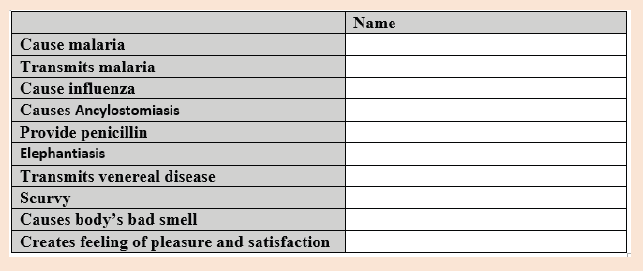UNIT 2: COMMON DISEASES AND HYGIENE
Key unit competence
Implement ways of preventing and controlling common diseases and hygiene related issues.
Introductory Activity
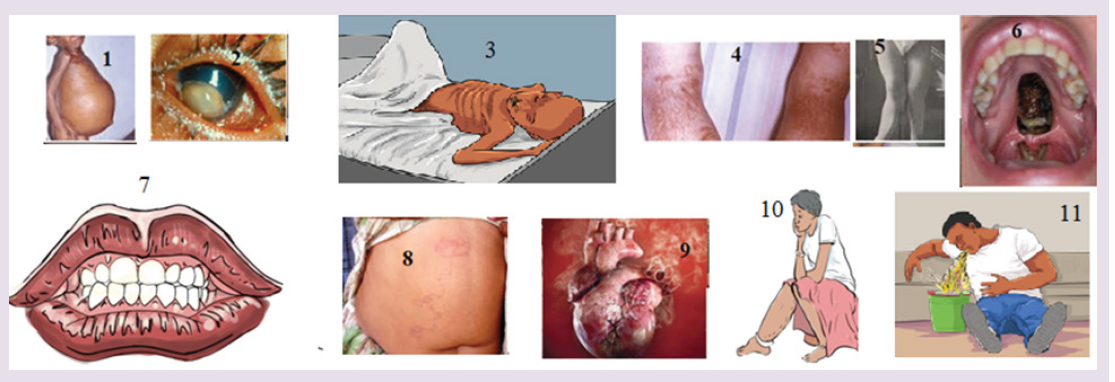
The figure 1-11 indicates different situations.
a) According to what you always observe in community you live in, suggest what happened.
b) What do you think is a cause of each case in figure?
c) What can you do in community for limiting those situations?
2.1. Common diseases
Activity 2.1.a
1) The government of Rwanda encourages people to visit hospitals and test their blood. A person has done that test and he found having HIV positive.
a. Which opportunistic information can be associated with HIV?
b. What is its causative agent?
c. How is it transmitted from one people to another?
2) Basing on the ways of transmission, suggest other diseases that can be transmitted as the disease stated in a.1
3) How can you prevent those diseases?
Infectious diseases are caused by microorganisms known as pathogens which may include viruses, bacteria, fungi and protozoa. Those diseases are called communicable diseases as they can be transmitted from one person to another. They include cholera, malaria, typhoid, HIV and AIDS...Malaria is one of the most dangerous infectious diseases, endemic in Latin America, Africa and South-East Asia.
Some infectious diseases can also be from animals to humans.
Some technical terms used when discussing about infectious diseases are:
– Aetiology: The study of the cause of disease.
– Epidemiology: The study of all the factors that contribute to the appearance of a particular disease
– Causative agent: The organism which causes the disease
– Vector: An organism which carries the causative agent of the disease from one person to another or from infected animal to human.
– Incubation period: The period of time between the original infection and the appearance of signs and symptoms.
– Infective period: The time during which a person is capable of passing the disease on to another person.
– Carrier: The person who has been infected but develop no signs and symptom, the carrier can pass the disease on to another person.
– Prevention: Measures taken to prevent diseases.
– Treatment: Measures taken to cure diseases.
– Antibody: Is a protein produced by the body’s immune system when it detects harmful substances called antigen.
– Antigen: Is any substance that causes your immune system to produce antibodies against it.
– Host: A host can be anything living organism ion which pathogens can survive
– Hygiene: Practices that help to maintain health and prevent the spread of diseases
– Immunity: Is the ability of the body to resist to infections.
Some groups of communicable diseases
• Bacterial diseases: these are diseases caused by bacteria. They include cholera, typhoid, tetanus, tuberculosis, etc.
• Viral diseases: these are diseases caused by viruses. They include AIDS, polio, measles, Ebola, etc.
• Protozoan diseases: these are diseases caused by protozoa. They include malaria, sleeping sickness, trichomoniasis, etc.
• Fungal diseases: these are diseases caused by fungi. They include candidiasis, athlete’s foot, ring worms, etc.
• Worm diseases: these are diseases caused by worms. They include elephantiasis, bilharzias, etc.
• Sexually transmitted diseases: these are diseases transmitted through sexual contact. They include HIV-AIDS, syphilis, gonorrhea, etc. c.
Transmission of infectious diseases
Pathogens can spread when you have direct contact with an infected person.
For example, if you have contact with the person’s blood, body fluids or open wounds. Pathogens can also be spread through contaminated food, water or air. Infected animals can spread pathogens to people.
The following conditions lead to the spread of an infectious disease:
• A pathogen which causes the disease.
• A source which is an infected organism.
Mode of transmission: A pathogen must be able to enter the body of the new host to cause an infection. Infectious diseases follow a pattern of development from the time of infection.
2.1.1. Cholera
Cholera is a good example of a waterborne disease. It is endemic in parts of Asia, particularly India. The organism which causes cholera is a comma shaped motile bacterium called Vibrio cholerae.
a) Transmission and symptoms of cholera
The main source of infection is water contaminated by feces with Vibrios.
It is estimated that only about one infected person in 50 develops the disease, the rest being carriers. Drinking contaminated water, or washing food or utensils in it, is the most common means of transmission. Direct contamination of food with feces as a result of poor hygiene is also possible, house flies being the main vector in this last case.

b) Signs and symptoms of cholera
Vibrio cholerae multiply in the intestine, releasing a powerful toxin which results in violent inflammation of the intestine and production of the watery diarrhea.
The main sign of the disease is severe diarrhea due to irritation of the bowel by toxins from the vibrios. The liquid of the feces is so profuse and cloudy like “rice water”.
Abdominal pain and vomiting are also common. Dehydration is rapid and quickly results in death unless rehydration treatment is given.
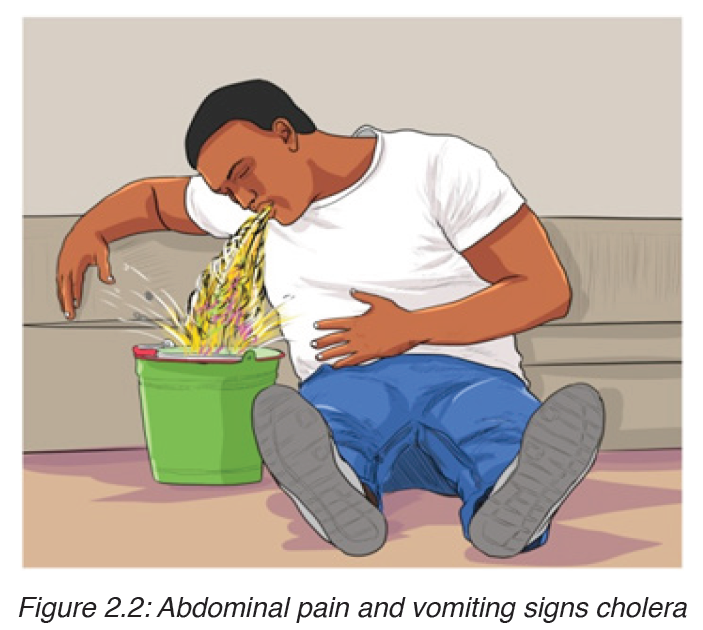
Fever is absent; in fact, the skin feels deathly cold and often damp.
Table 2.1: The features of cholera.
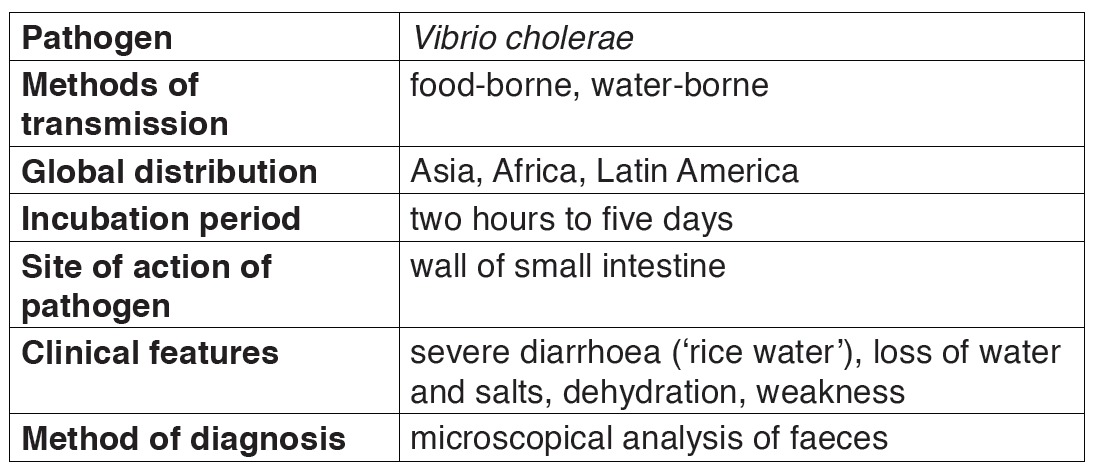
c) Treatment of cholera
The prime cause of death from cholera is dehydration i.e. loss of water with its minerals salts. For that it is obligatory to rehydrate with oral serum which contain mineral salts and sugar, The fluid lost may be replaced by administration of a drip food into a vein.
Various antibiotics, such as tetracyclines and chloramphenicol, are used to treat cholera. Chloramphenicol is effective against tetracycline-resistant vibrias.
d) Prevention of cholera
– Use clean drinking water,
– Proper treatment of sewage and sanitation
– High standards of public and personal hygiene, particularly in relation to food ( such as washing hands after defecation)
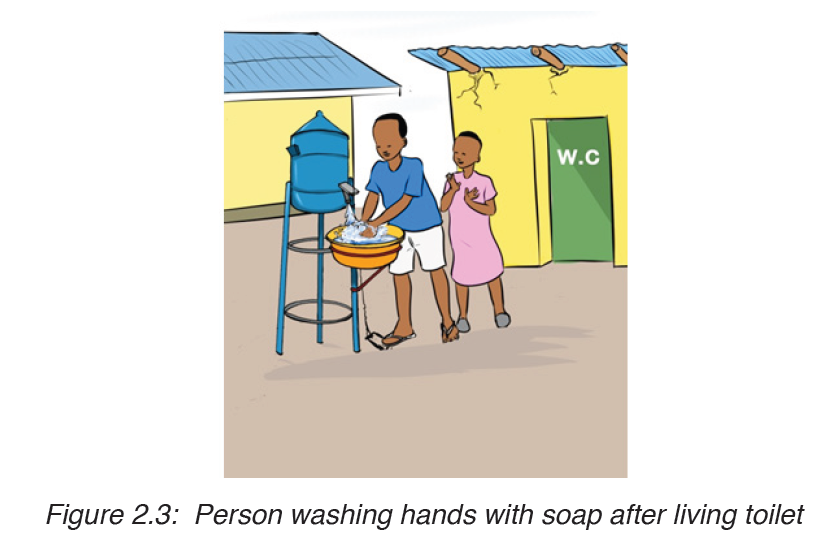
– Health education
– Vaccination is recommended for people visiting areas where cholera is endemic and for those living in such areas. But this vaccine lasts few months.
– Isolation of patients and hygienic disposal of feces and vomit from patients.
e) Failure to eradicate cholera
– Vaccination is not very effective
– It is a waterborne disease i.e. transmitted through contaminated water
– Poor sanitation condition in camps.
2.1.2. Tuberculosis
a) Causal agent of tuberculosis
Tuberculosis is caused by bacterium called Mycobacterium tuberculosis, first discovered by Robert Koch in 1882. It is sometimes referred to as the tubercle bacillus, bacilli being rod-shaped bacteria. The common form is pulmonary TB which infects the lungs, although other organs may be affected.
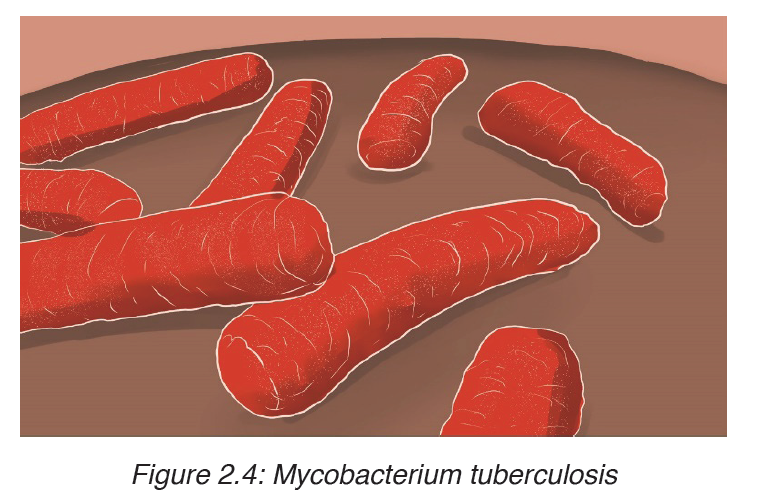
Two strains of the bacterium may cause the disease, the human and the bovine forms. The latter can be present in cattle and can enter the milk of cows. It is very resistant and can remain alive for long time in milk products as well as in durst.
Table 2.2: Features of TB.
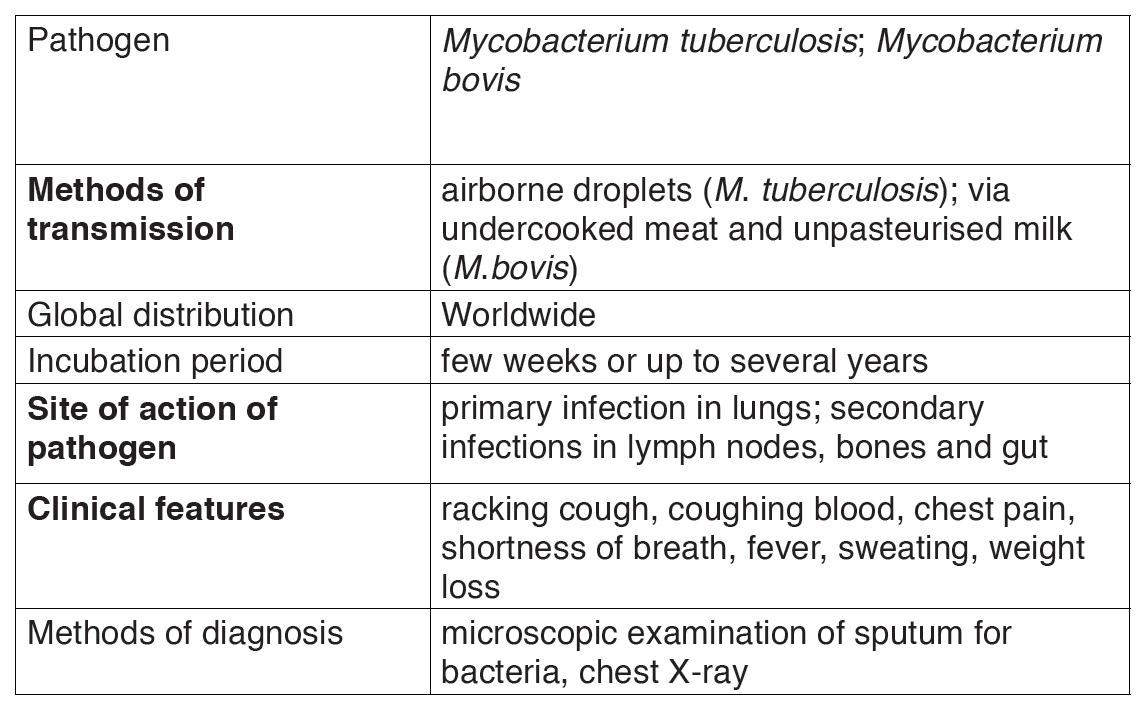
b) Transmission of tuberculosis
Tuberculosis is mainly airborne disease. The infection is done through the droplets from the patient.
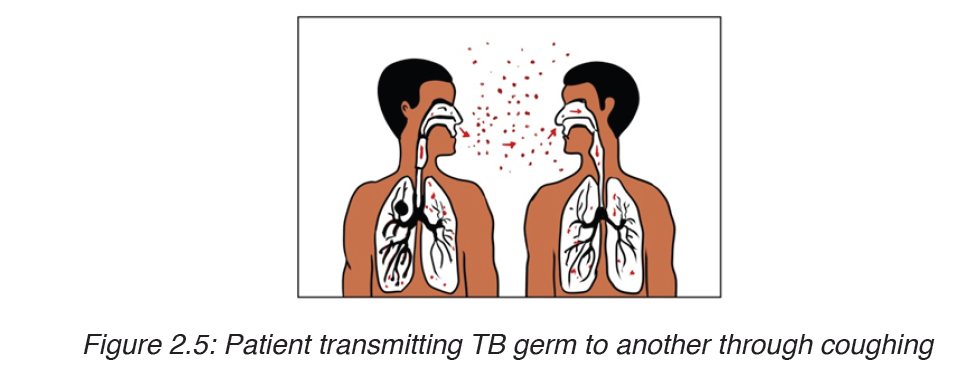
It is much less infectious than the common cold and requires prolonged contact between people, poor ventilation and overcrowded living conditions.
Other factors include poverty, bad housing, malnutrition, age, smoking and AIDS. In addition, TB is an opportunistic infection, striking many people with a depressed immunity.
c) Signs and symptoms of tuberculosis
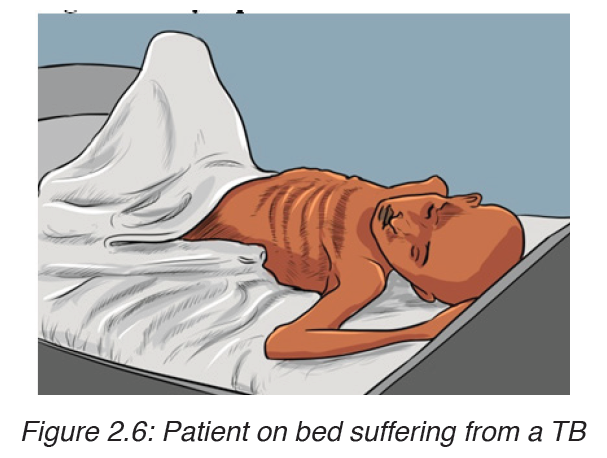
The disease frequently shows itself by vague symptoms such as: loss of appetite; loss of weight; excessive sweating; coughing, appearance of blood in the sputum, pains on the chest, shortness of breath (case of lung tuberculosis).
d) Treatment and prevention of tuberculosis
The development of an effective vaccine against the disease result of the work of Abert Calmette and Camile guérin (BCG). A cure for people already affected by T.B did not come until 1843 when the antibiotic streptomycin was discovered. The number of cases started to fall more rapidly after this and continued to decline aided by introduction of further antibiotics such as rifampicin, isoniazid and others.
e) Failure to eradicate tuberculosis
– Patients can carry pathogen and infection without showing symptoms.
Therefore they are difficult to identify and isolate / long period of incubation
– Germs of tuberculosis can survive longer in the house dust
– The disease is related to poverty where many people share the same room and have malnutrition.
– The disease is associated with AIDS that reduced the body immunity
– Long period of medication (6-8 moths), hence patients give up when not yet fully healed. The pathogens then form endospores that resists to medicines.
– The disease is also spread through milk from infected animals. Hence it is difficult to vaccinate.
– Tuberculosis is an airborne disease i.e. spread in air.
2.1.3. Malaria
a) Causal agent of Malaria
Human malaria is caused by infections from four species of plasmodium:
Plasmodium falciparum, P. vivax, P. ovale, and P. malariae, each responsible for a different form of the disease.
Malaria is characterized by chills, fever, and, in the most severe cases, coma leading to death.
The parasite, Plasmodium is transmitted by the bite of female mosquitoes (the vector) belonging to the genus Anopheles.
The life cycle of Plasmodium involves both sexual reproduction within the host mosquito, and asexual reproduction within the human being.
It is the reproductive activity of the parasite within the human bloodstream that produces the characteristic recurrent attacks of the disease.
The infection begins when a mosquito vector injects parasite particles (infectious stages) called sporozoites, present in the mosquito’s saliva, into the bloodstream when it feeds on a human blood.
b) Symptoms
Malaria is a very serious disease characterized by severe chills, fever, sweating, fatigue and great thirst. Malaria is caused by a protozoan of the genus Plasmodium.
Victims die of anemia, kidney failure or brain damage. The genus Plasmodium infects humans, and all have life cycles that involve the female anopheles mosquito.
c) Life cycle of Plasmodium
It is the reproductive activity of the parasite within the human bloodstream that produces the characteristic recurrent attacks of the disease.
The infection begins when a mosquito vector injects parasite particles (infectious stages) called sporozoites, present in the mosquito’s saliva, into the bloodstream when it feeds on a human blood.
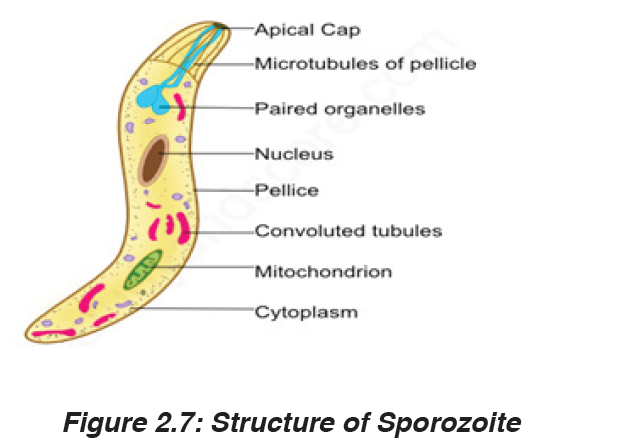
These enter liver cells where they multiply by asexual reproduction for about 7 to 14 days (the incubation period of the disease) before producing daughter cells called merozoite, which invade red blood cells. The parasites multiply in the red cells, again by asexual reproduction, to produce between 8 and 16 merozoites every 48 or 72 hours, depending on the species of Plasmodium. These merozoites are released by the bursting of the infected red blood cells and the cycle is repeated.
The bursting of the red blood cells and the release of toxic substances cause the characteristic fever of malaria. After a number of such cycles, sexual stages, male and female gametocytes, are produced, and these are taken up by a feeding mosquito, in which the Plasmodium life cycle is completed by sexual reproduction, resulting in new sporozoites.

d) Prevention of malaria
- Drainage of stagnant water: The larval stages of the mosquito live in stagnant water, so drainage removes breeding sites. This has had some success.
- Destruction of the breeding sites of the mosquito: The larvae and pupae of mosquitoes obtain their oxygen by means of small tubes which are pushed through the water surface film. Thus any method of blocking these tubes will result in the death of the intermediate life stages of the mosquito (petrol, oil….)
- Destruction of the adult mosquitoes: This is aimed at killing the mosquitoes that enter houses. Thus, the indoor surfaces are sprayed with a persistent insecticide.
Use of mosquito nets.
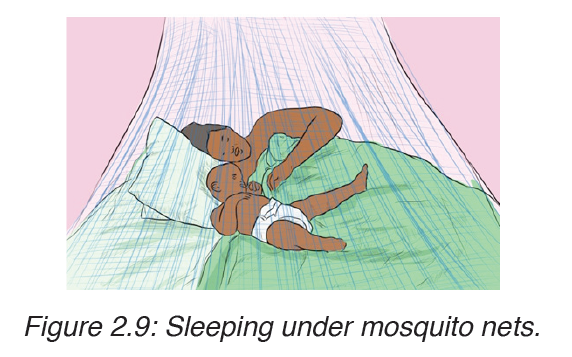
e) Occurrence of malaria
The disease now occurs in tropical and subtropical regions of the world, and its distribution is limited by conditions that are inimical to the development of the mosquito vector, such as temperature and altitude.
Malaria is endemic in tropics because:
– Tropical climate provides the best breeding and living conditions for the Anopheles mosquito which transmits malaria
– The Anopheles cycle requires areas of stagnant water and these are common within tropics
– In the tropical areas there is presence of bushes or abundant vegetation which makes suitable habitat for mosquitoes
Plasmodium needs temperature in excess of 20ᵒC for it to complete its cycle within the mosquito.
Table 2.3: The features of malaria

Treatment of malaria
The common drugs used in treatment of malaria include the following:
Chloroquine, Atovaquone-proguanil (Malarone), Artemether-lumefantrine (Coartem), Mefloquine, Quinine, Doxycycline (used in combination with quinine)
f) Failure to eradicate malaria
– There is no effective vaccine against malaria
– The pathogens are transmitted by mosquitoes which are not eradicated.
– The plasmodium have become resistant to different anti-malarial drugs
– Ignorance of some people toward the disease and how it is spread.
2.1.4. HIV/AIDS and other Sexual Transmission Diseases (STD)
AIDS (Acquired Immune Deficiency Syndrome) is a disorder which damages the human body’s immune system. It is caused by the HIV virus (Human Immunodeficiency Virus).
This is an RNA virus. The virus replicates inside the T4 lymphocytes or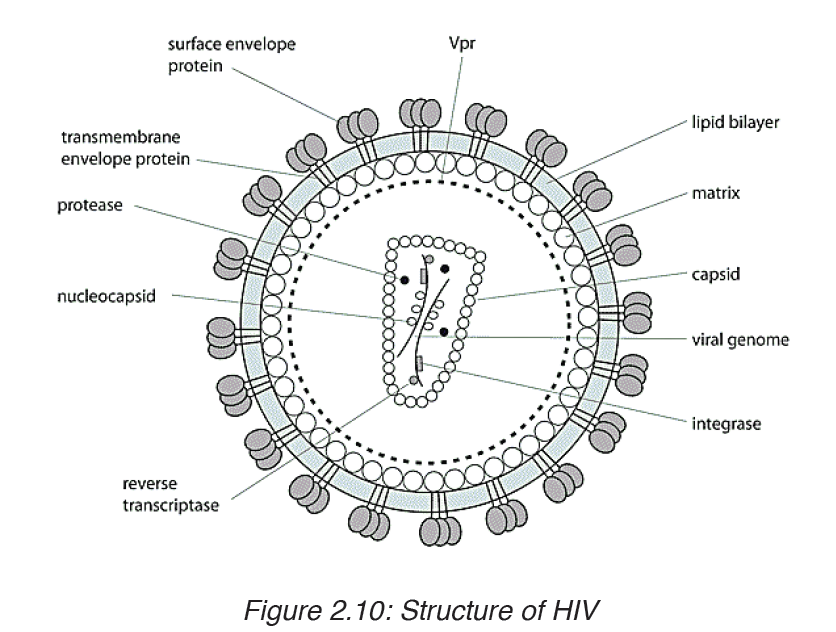
helper T cells. Thus these cells can no longer help or induce other T cells,
called killer cells, to fight invaders. The body’s immune system breaks down
leaving the patient exposed to a variety of diseases called opportunistic
infections. AIDS is not a disease; it is a collection of these opportunistic
diseases associated with immunodeficiency caused by HIV infection. It is
important to realize, however, that the infection with the HIV virus does not
necessarily result in AIDS. As with other diseases, some people remain
symptomless and are therefore called carriers.
TRANSMISSION, SIGNS AND SYMPTOMS
The HIV virus can only survive in body fluids and is transmitted by blood orsemen. In 90% of cases the transmission is achieved by sexual contact.
People can contract the disease as follows:
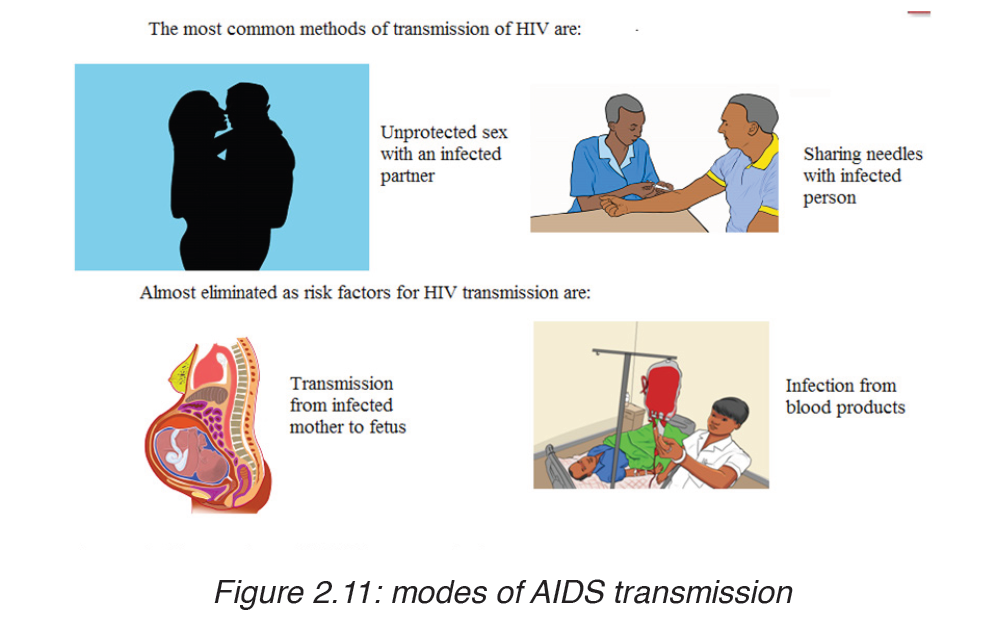
– Intimate sexual contact. The most frequent mode of transmission of HIV is through sexual contact with an infected person.
– Infected blood entering bloodstream: by means of unsterilized needles and syringes. Unfortunately the disease can be contracted after being given blood or blood products already infected with HIV.
Close contact between infected and non infected people through cuts and open wounds has also been known to pass on the virus.
– From mother to baby: An infected pregnant woman can pass on the virus to her baby through the placenta, at birth or through breast milk during suckling. The chances of infection being transmitted from the mother to her baby are currently estimated to be 25-50%.
TEST FOR THE DISEASE
A blood test is used to tell whether or not a person has been infected by the HIV virus. Under normal circumstances the immune system reacts to infection by producing antibodies and when the HIV virus enters the body, anti-HIV antibodies are produced. The blood of the person being tested is added to HIV proteins which have been commercially prepared. If there are anti-HIV antibodies in the blood sample they will bind to the viral proteins and the person is described as HIV positive. However, if the test proves negative that person may still be infected. This is because it takes up to three months or longer for HIV antibodies to be produced after infection.
PREVENTION OF THE DISEASE
There are many precautions which can be followed in trying to prevent the disease:

The use of a barrier during intercourse can prevent the virus from infecting through blood or semen. Thus the use of a sheath or condom is recommended.
This practice has been encouraged through many advertising campaigns throughout the world.
• Restriction to one sex partner and the absence of promiscuity will also clearly reduce the risk of infection.
• A reduction in the spread of HIV can be brought about by the use of clean needles and syringes by drugs addicts.
• The blood donated should be tested for the presence of antibodies to HIV which indicates whether or not the donor is infected. Blood containing these antibodies is not used.
• Educating the people about the disease.
• Taking antiretroviral during pregnancy and delivery.
• To avoid breastfeeding and to administer antiretroviral drugs to the newborn.
Table 2.4: The features of HIV/AIDS

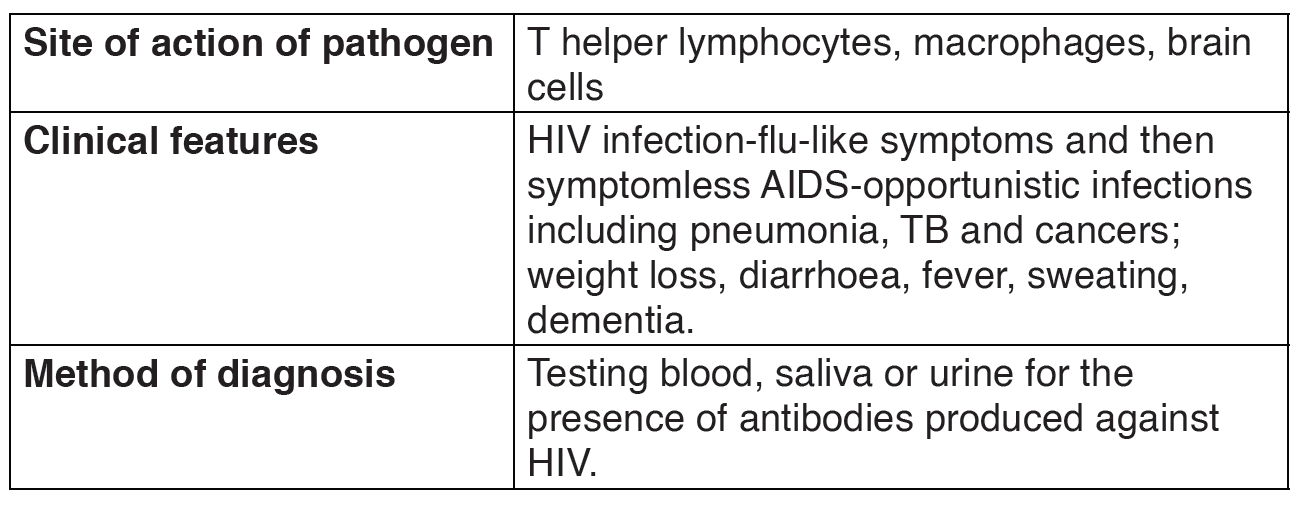
Other sexual transmission diseases (STD)
Sexually transmitted diseases (STDs) are transmitted by infected persons to healthy persons during sexual intercourse.
Sexually transmitted diseases (STD), also referred to as sexually transmitted infections (STI) and venereal diseases (VD), are illnesses that have a significant probability of transmission between humans by means of sexual behavior, including vaginal intercourse, anal sex and oral sex. Some STIs can also be contracted by using drug needles after their use by an infected person, as well as through any incident involving the contact of a wound with contaminated blood or through childbirth or breastfeeding.
Sexually transmitted infections have been well known for hundreds of years, and venereology is the branch of medicine that studies these diseases.
While in the past, these illnesses have mostly been referred to as STDs or VD, the term sexually transmitted infections (STIs) has been preferred by many up-to-date medical sources, as it has a broader range of meaning; a person may be infected, and may potentially infect others, without having a disease.
There are 19 million new cases of sexually transmitted infections every year in the United States, and, in 2005, the World Health Organization estimated that 448 million people aged 15–49 were being infected a year with curable STIs (such as syphilis, gonorrhea and chlamydia).
Until the 1990s, STIs were commonly known as venereal diseases, the word venereal being derived from the Latin word venereus, and meaning relating to sexual intercourse or desire, ultimately derived from Venus, the Roman goddess of love. Social disease was a phrase used as a euphemism.
While many people with STDs show no signs or symptoms of their infection, when there are signs of STDs they are most likely to be in the genital area.
The genital area in women includes the vulva (the area around the vagina including the lips), vagina (the opening where menstrual blood comes out),buttocks, urethra (the opening above the vagina where urine comes out) and anus (the opening where a bowel movement comes out). The genital area in men includes the penis, scrotum (“balls”), urethra, and anus.
What Are the Symptoms of STDs?
Sometimes, there are no symptoms of STDs. If symptoms are present, they may include one or more of the following:
• Bumps, sores, or warts near the mouth, anus, penis, or vagina.
• Swelling or redness near the penis or vagina.
• Skin rash.
• Painful urination.
• Weight loss, loose stools, night sweats.
• Aches, pains, fever, and chills.
• Yellowing of the skin (jaundice).
• Discharge from the penis or vagina. (Vaginal discharge may have an odor.)
• Bleeding from the vagina other than during a monthly period.
• Painful sex.
• Severe itching near the penis or vagina.
Examples of these diseases are chlamdia, gonorrhoea, syphillis and, HIV and AIDS.
1. Chlamydia
Chlamydia is caused by the bacterium Chlamydia trachomatis.
The disease is spread by oral, vaginal or anal sex, and also through touch, for example, touching the eyes with a contaminated hand, may lead to conjunctivitis. Chlamydia can also be passed to the infant during birth.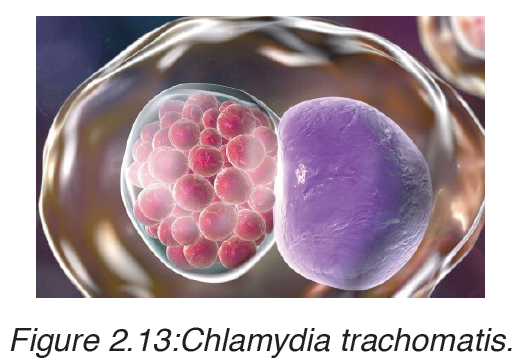
It causes inflammation of the cervix in women, urethra and rectum in both men and women. Occasionally, other parts of the body like eyelids and throat may be affected. Any sexually active person is at risk of contracting the disease. However, it is more common in young people.
The disease is known as a ‘silent’ infection because it is mainly asymptomatic, thus the symptoms can be mild or be confused with gonorrhea.
Signs and symptoms of chlamydia
In males
• Pain when passing out urine.
• White discharge from the penis.
• The testicles may be painful or swollen.
• Swelling of skin around the anus.
In females
• Painful and frequent urination.
• Smelly yellowish and abnormal vaginal discharge.
• Pain in the lower abdomen.
• Swollen skin in the vagina or around the anus.
Treatment
Chlamydia is easily treated using antibiotics usually Azithromycin or doxyclyne.
2. Gonorrhoea
Gonorrhoea is transmitted through sexual contact with the penis, vagina, mouth or anus of an infected partner. Gonorrhoea can also be spread from mother to baby during childbirth. Gonorrhoea is caused by a bacterium called Neisseria gonorrhoeae.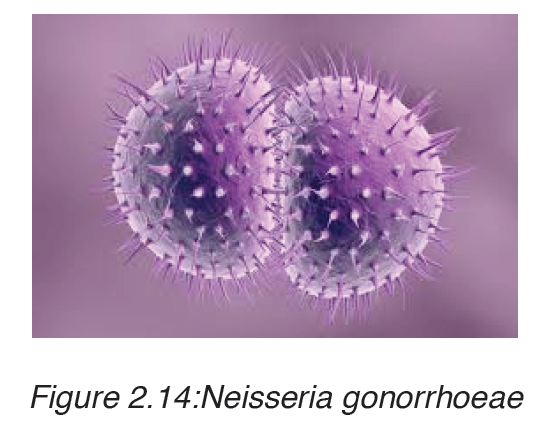
The bacteria attaches on the epithelial cells of the vagina or male urethra.
This results in inflammation and discharge of pus. If left untreated, the infection spreads to the other reproductive parts and may eventually block the passages resulting to infertility. Signs and symptoms of gonorrhea.
Some men with gonorrhea may have no symptoms at all. However, men who do have symptoms may have:
• A burning sensation when urinating.
• A white, yellow, or green discharge from the penis.
• Painful or swollen testicles (although this is less common).
Most women with gonorrhea do not have any symptoms. Even when a woman has symptoms, they are often mild and can be mistaken for a bladder or vaginal infection.
Women with gonorrhea are at risk of developing serious complications from the infection, even if they do not have any symptoms.
Symptoms in women can include:
• Painful or burning sensation when urinating.
• Increased vaginal discharge.
• Vaginal bleeding between periods.
Treatment
Gonorrhea can be treated using antibiotics like penicillin.
3. Syphilis
Syphilis is transmitted from person to person by direct contact with a syphilitic sore, known as a chancre. Chancres occur mainly on the external genitals, vagina, anus or in the rectum. Chancres also can occur on the lips and in the mouth.
Transmission of syphilis occurs during vaginal, anal or oral sex.
Syphilis is caused by a bacteria called Treponema pallidum.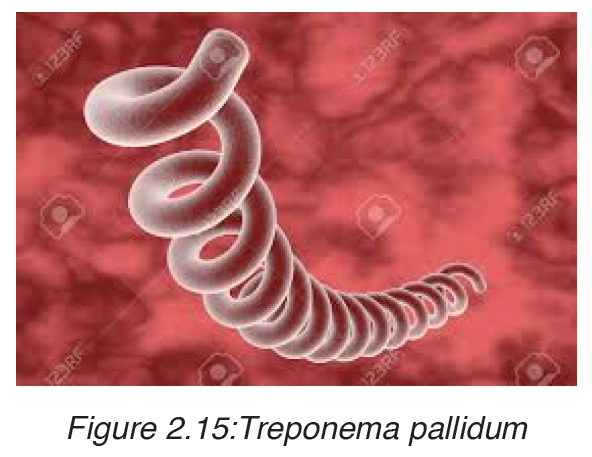
The bacterial infection progresses through several stages:
• In the primary stage, small hard painless sores develop at the site of infection usually the penis and the vagina.
• The disease enters secondary stage several weeks later characterized by rashes on the skin and mild fever. These symptoms subside after a few weeks followed by a latent asymptomatic period.
• In the tertiary stage, lesions develop and cause extensive tissue damage that may lead to paralysis, insanity, blindness and eventually death.
Treatment
Antibiotics like penicillin, erythromycin or tetracycline are used to treat syphilis although some strains can be resistant to certain antibiotics.
The following are general ways of reducing STDs and HIV infection:
a) Abstinence is the only sure way to prevent STDs.
b) Being faithful to one trusted partner.
c) Using condoms every time when engaging in sexual intercourse.
Condoms are not 100% effective at preventing disease or pregnancy.
However, they are extremely effective if used properly.
d) Reduce the number of sexual partners.
e) Avoid sharing towels or underclothing.
f) Get a vaccination for hepatitis B.
g) Get tested for HIV.
h) Avoiding alcohol consumption and abuse of drugs. Individuals who are drunk or on drugs often fail to have safe sex.2.5 Table summarizing sexual transmitted infections
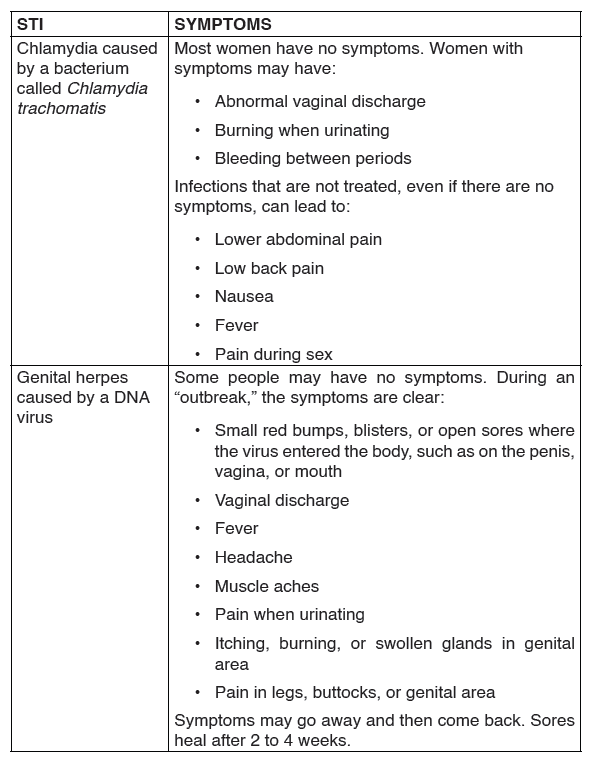
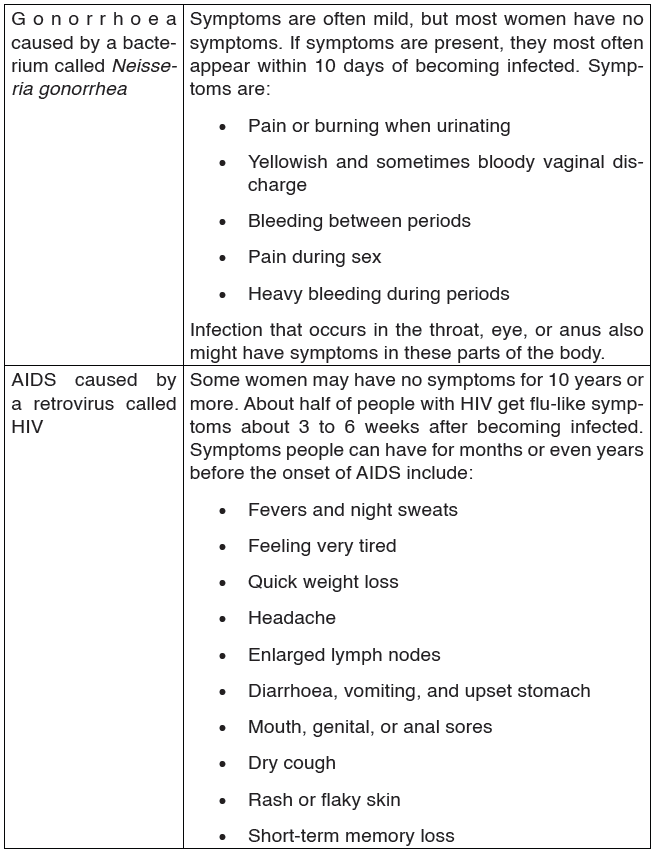
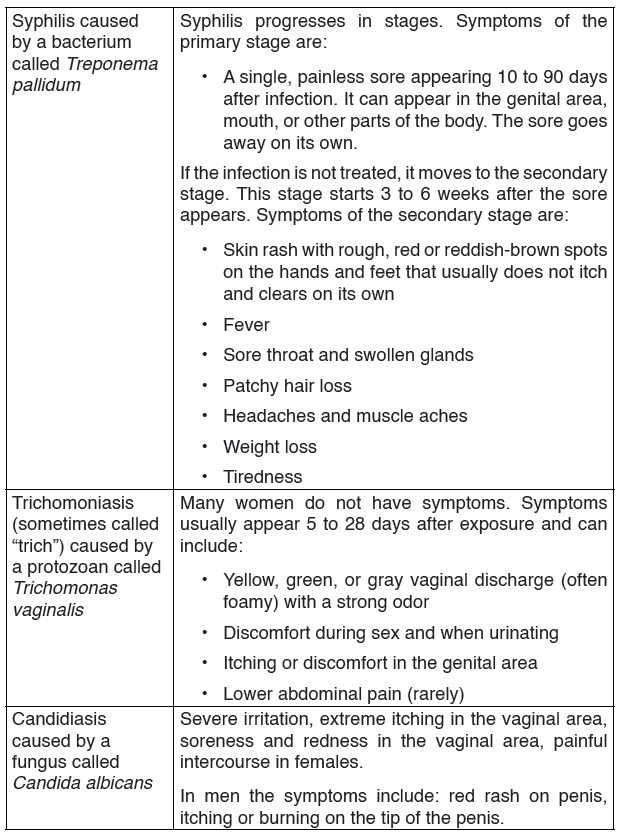

• DEFICIENCY DISEASES:
Deficiency diseases these are also known as malnutrition or macronutrient deficiencies. They are diseases that are caused by a dietary of specific nutrients, especially a vitamin or mineral, possibly coming from insufficient intake, digestion, absorption, or utilization of a nutrient. The deficiency diseases are common in Africa due to the poverty, and bad use of nutrients.
The examples of common deficiency diseases are Kwashiorkor, Marasmus, Vitamin deficiencies.
1. KWASHIORKOR
Kwashiorkor is deficiency disease known as ‘wet malnutrition’ caused by eating a food of energy giving food without adequate proteins.
Signs and symptoms of kwashiorkor
The following are well defined symptoms and signs
– Pitting edema (swelling of the ankles and feet).
– Distended abdomen,
– An enlarged liver with fatty infiltrates,
– Thinning of hair,
– Loss of teeth,
– Skin depigmentation and dermatitis.
Children suffering from kwashiorkor often develop irritability and anorexia.
Mode of Prevention
To prevent from kwashiorkor, a person should be given small but frequent rations in every two to four hours. During the first week, he or she must be given a diet high in sugar and enriched in protein as well as essential elements: sweet milk with mineral salts and vitamins. The diet may include lactases so that children who have developed lactose intolerance can ingest
dairy products and antibiotics to compensate for immunodeficiency.
After two to three weeks, the milk is replaced by boiled cereals fortified with minerals and vitamins until the person’s mass is at least 80% of normal weight.
Treatment of the disease
– Generally, the disease can be treated by adding protein to the diet;
however, it can have a long-term impact on a child’s physical and mental development, and in severe cases may lead to death.
2. MARASMUS
Marasmus is also known as “dry malnutrition”. It is a form of severe malnutrition that usually occurs in children. It typically occurs in developing countries. Marasmus can be life-threatening, but you can get treatment for it.
Causes of marasmus
Nutrient deficiency is the main cause of marasmus. It occurs in children that do not eat enough protein, calories, carbohydrates, and other important nutrients. This is usually due to poverty and a scarcity of food.
Symptoms of marasmus
In children with marasmus, the following are symptoms:
• Chronic diarrhea
• Respiratory infections
• Intellectual disability
• Being underweight
• Stunted growth
• Subcutaneous fat is the layer of fat just under the skin.
• Dry skin and brittle hair
• Children may look older.• Children are short-tempered and irritable
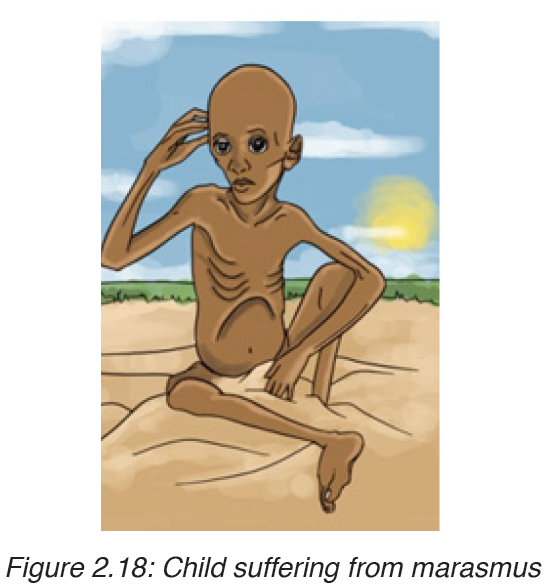
OTHER DEFICIENCY DISEASES
Most of these diseases are micro-nutrient deficiencies like goitre, anaemia,
night blindness, rickets, obesity.
1. Goitre
The goitre is the swelling in the neck caused by lack of an adequate iodine
in the diet the pregnant mother
Prevention and treatment
– Eat food rich in iodine
– Go to doctor for treatment and the surgery is done to remove the
swelling
2. Anaemia
This disease is due to luck of an adequate Iron mineral in the diet. The iron
is essential for formation of haemoglobin pigment of blood contained by red
blood cells. If haemoglobin is not formed due to lack of iron, the oxygen will
not be transported into the body, hence the person with anaemia becomes
tired easily and has little energy to do a given work due to inadequate oxygen
in the body.
Signs and symptoms
– Shortness of breath
– Filling weak and tired quickly
– Filling one has no energy to work
– Inside the eyelids and tongue looks pale
– Short attention span
Prevention and treatment
– Regular taking lots of leafy vegetables to provide iron
– Eat food with plenty of calcium and vitamin D
• VITAMIN DEFICIENCIES
3. Scurvy
Scurvy happens when there is a lack of vitamin C, or ascorbic acid. The
deficiency leads to symptoms of weakness, anemia, gum disease, and skin
problems.
This is because vitamin C is needed for making collagen, an important
component in connective tissues. Connective tissues are essential for
structure and support in the body, including the structure of blood vessels.
A lack of vitamin C will also affect the immune system, absorption of iron,
metabolism of cholesterol and other functions.
Symptoms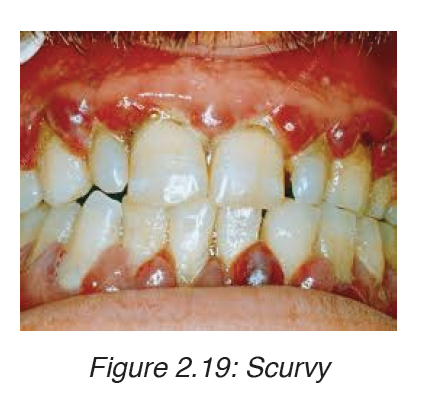
Symptoms of vitamin C deficiency can start to appear after 8 to 12 weeks.
Early signs include a loss of appetite, weight loss, fatigue, irritability, and
lethargy.
Within 1to 3months, there may be signs of:
– Anemia
– Myalgia, or pain, including bone pain
• Swelling, or edema
• Petechiae, or small red spots resulting from bleeding under the skin
• Corkscrew hairs
• Gum disease and loss of teeth
• Poor wound healing
• Shortness of breath
• Mood changes, and depression
Treatment
Treatment involves administering vitamin C supplements by mouth or by
injection.
The recommended dosage is:
• 1 to 2 grams (g) per day for 2 to 3 days
• 500 milligrams (mg) for the next 7 days
• 100 mg for 1 to 3 months
Within 24 hours, patients can expect to see an improvement in fatigue,
lethargy, pain, anorexia, and confusion. Bruising, bleeding, and weakness
start to resolve within 1 to 2 weeks.
After 3 months, a complete recoveryis possible. Long-term effects are
unlikely, except in the case of severe dental damage.
Prevention
Scurvy can be prevented by consuming enough vitamin C, preferably in the
diet, but sometimes as a supplement.
During pregnancy, women should consume 85 mg of vitamin C, rising to 120
mg while breastfeeding.Smokers need 35 mg more than nonsmokers every day.
4. Rickets
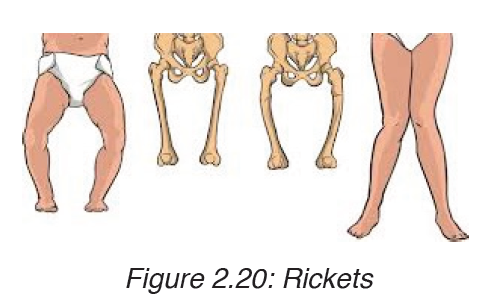
Rickets is a skeletal disorder that’s caused by a lack of Vitamin D, calcium,or phosphate which are nutrients important for the development of strong,healthy bones. The sufferer of rickets may have weak and soft bones, stunted growth, and, in severe cases, skeletal deformities.
Symptoms of rickets
Symptoms of rickets include:
• Pain or tenderness in the bones of the arms, legs, pelvis, or spine
• Stunted growth and short stature
• Bone fractures
• Muscle cramps
• Teeth deformities, such as: delayed tooth formation, holes in the enamel, abscesses, defects in the tooth structure, an increased number of cavities
• skeletal deformities, including: an oddly shaped skull, bowlegs, or legs that bow out, bumps in the ribcage, a protruding breastbone, a curved spine, pelvic deformities
Rickets treatment
Treatment for rickets focuses on replacing the missing vitamin or mineral in the body. This will eliminate most of the symptoms associated with rickets. The exposure to sunlight, if possible is recommended. To consume food products high in vitamin D, such as fish, liver, milk, and eggs is also necessary.
If skeletal deformities are present, the child may need braces to position their bones correctly as they grow. In severe cases, the child may need corrective surgery.
For hereditary rickets, a combination of phosphate supplements and high levels of a special form of vitamin D are required to treat the disease.
Prevention
– The best way to prevent rickets is to eat a diet that includes adequate amounts of calcium, phosphorous, and vitamin D. People with kidney disorders should have their calcium and phosphate levels monitored on a regular basis by their doctors.
– Rickets can also be prevented with moderate sun exposure. We need to expose the hands and face to sunlight a few times a week during the spring and summer months to prevent rickets.
5. Beriberi
Beriberi is a disease caused by a vitamin B-1 deficiency, also known as
thiamine deficiency. There are two types of the disease: wet beriberi and dry
beriberi.
Wet beriberi affects the heart and circulatory system. In extreme cases, wet
beriberi can cause heart rate
Dry beriberi damages the nerves and can lead to decreased muscle strength
and eventually,muscle paralysis. Beriberi can be life-threatening if it isn’t
treated.
Today, beriberi mostly occurs in people with an alcohol use disorder. Still,
the disease can be seen in women who have extreme nausea and vomiting
in pregnancy, in people with AIDS, and after bariatric surgery.
Symptoms of beriberi
The symptoms of beriberi vary depending on the type.
Wet beriberi symptoms include:
• Shortness of breath during physical activity
• Waking up short of breath
• Rapid heart rate
• Swollen lower legs
Dry beriberi symptoms include:
• Decreased muscle function, particularly in the lower legs
• Tingling or loss of feeling in the feet and hands
• Pain
• Mental confusion
• Difficulty speaking
• Vomiting
• Involuntary eye movement
• Paralysis
Beriberi treatment
Beriberi is easily treated with thiamine supplements. Doctor may prescribe
a thiamine shot or pill. For severe cases, a healthcare professional will
administer intravenous thiamine.
Prevention
– To prevent beriberi, eat a healthy, balanced diet that includes foods
rich in thiamine. These include: beans and legumes, seeds, meat, fish,
whole grains, nuts, dairy, certain vegetables, such as asparagus, acorn
squash, Brussels sprouts, spinach, and beet greens and breakfast
cereals that are enriched with thiamine
– Cooking or processing any of the foods listed above decreases their
thiamine content.
– Always be sure to purchase infant formula from a reliable source.
– Limiting alcohol consumption will reduce your risk of developing beriberi
6. Pellagra
Pellagra is a disease caused by low levels of niacin, also known as vitamin
B-3. It’s marked by dementia, diarrhea, and dermatitis, also known as “the
three Ds”. If left untreated, pellagra can be fatal.
Symptoms
The main symptoms of pellagra are dermatitis, dementia, and diarrhea.
Dermatitis related to pellagra usually causes a rash on the face, lips, feet, or
hands. In some people, dermatitis forms around the neck.
Additional dermatitis symptoms include:
• Red, flaky skin
• Areas of discoloration, ranging from red to brown
• Thick, crusty, scaly, or cracked skin
• Itchy, burning patches of skin
As the disease progresses, possible dementia symptoms include: apathy,
depression, confusion, irritability, or mood changes, headaches, restlessness
or anxiety, disorientation or delusions
Other possible pellagra symptoms include: sores on the lips, tongue, or
gums, decreased appetite, trouble eating and drinking, nausea and vomiting
Causes
There are two types of pellagra, known as primary pellagra and secondary
pellagra.
Primary pellagra is caused by diets low in niacin or tryptophan. Tryptophan
can be converted to niacin in the body, so not getting enough can cause
niacin deficiency.
Secondary pellagra occurs when your body can’t absorb niacin.
There are things that can prevent from absorbing niacin like: alcoholism,
eating disorders, certain medications, including anti-convulsants and
immunosuppressive drugs, gastrointestinal diseases, such as ulcerative
colitis, cirrhosis of the liver, carcinoid tumors, Hartnup disease
Treatment
Primary pellagra can be treated by dietary changes and a niacin or
nicotinamide supplement.
Nicotinamide is another form of vitamin B3. If left untreated, primary pellagra
usually causes death after four or five years.
Treating secondary pellagra usually focuses on treating the underlying
cause. However, some cases of secondary pellagra also respond well to
taking niacin or nicotinamide either orally or intravenously.
7. Night blindness
This is a disease caused by lack of Vitamin A in the diet. The main sources
of vitamin A are green leafy vegetables, liver, egg yolk and milk products.

Symptoms
– Inability of seeing during night
Prevention
– Provide diet with a plenty of vitamin A
WORM DISEASES
In our country, even in other African country many people suffer from worm
diseases. There are many worms that can infest people due to poor sanitation.
Worms causing infection in people are parasites that live and breed mostly in the intestine. Infection is caused by worms such as roundworms, hookworms and tapeworms.

1. Ascariasis
Ascariasis is an infection of the and it is the most common roundworm
infection. Ascariasis is most common in places without modern sanitation.
People get the parasite through unsafe food and water. The infection
usually causes no symptoms, but a high number of roundworms (heavier
infestations) can lead to problems in the lungs or intestines.
Causes an ascariasis infection
You can become infected with ascariasis after accidentally ingesting the
eggs of the Ascaris lumbricoides roundworm. The eggs can be found in soil
contaminated by human feces or uncooked food contaminated by soil that
contains roundworm eggs.
Children often become infected when they put their hands in their mouths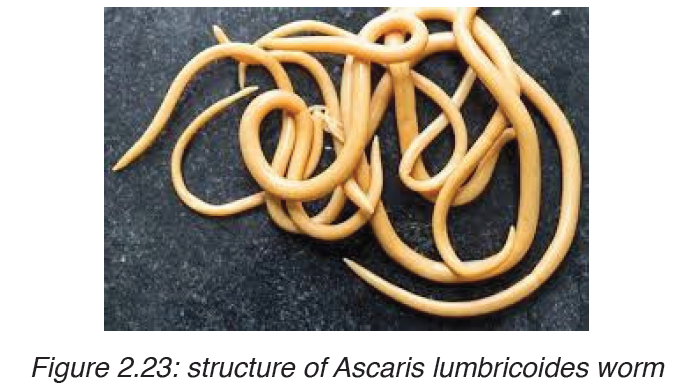
after playing in contaminated soil, even it can also be passed directly from
person to person.
Symptoms of ascariasis?
People with ascariasis often have no symptoms. Symptoms become more
noticeable when the roundworm infestation grows.
Roundworms in your lungs can cause:
• Coughing or gagging
• Wheezing or shortness of breath
• Aspiration pneumonia (rarely)
• Blood in mucus
• Chest discomfort
• fever
Roundworms in your intestines can cause:
• Nausea
• Vomiting
• Irregular stools or diarrhea
• intestinal blockage, which causes severe pain and vomiting
• Loss of appetite
• visible worms in the stool
• Abdominal discomfort or pain
• Weight loss
• Growth impairment in children due to malabsorption.
Life cycle of the roundworm
After ingestion, the A. lumbricoides roundworm reproduces inside your
intestine. The worm goes through several stages:
• Swallowed eggs first hatch in the intestine.
• The larvae then move through the bloodstream to your lungs.
• After maturing, the roundworms leave your lungs and travel to your
throat.
• You’ll either cough up or swallow the roundworms in your throat. The
worms that are swallowed will travel back to your intestine.
• Once they’re back in your intestine, the worms will mate and lay more
eggs.
• The cycle continues. Some eggs are excreted through your feces.
Other eggs hatch and return to the lungs.
Environmental risk factors for ascariasis include:
• lack of modern hygiene and sanitation infrastructure
• use of human feces for fertilizer
• living in or visiting a tropical or subtropical climate
• exposure to an environment where dirt might be ingested
You can limit your exposure to roundworms by avoiding unsafe food and
water. Keeping your immediate environment clean also helps. This includes
laundering clothing exposed to unsanitary conditions and cleaning cooking
surfaces well.
You should make sure to take precautions if you’re visiting a remote area.
It’s important to:
• Always wash your hands with soap and water before eating or preparing
food.
• Boil or filter your water.
• Inspect food preparation facilities.
• Avoid unclean common areas for bathing.
• Peel or cook unwashed vegetables and fruit in regions that lack
sanitation infrastructure or that use human feces for fertilizer.
Complications of ascariasis
Dangerous complications, including:
• Intestinal blockage. Intestinal blockage occurs when a mass of worms
blocks your intestines, causing severe pain and vomiting. Intestinal
blockage is considered a medical emergency and requires treatment
right away.
• Duct blockage.Duct blockage occurs when the worms block the small
passageways to your liver or pancreas.
• Nutritional deficiency. Infections that lead to loss of appetite and
poor absorption of nutrients put children at risk of not getting enough
nutrients, which can affect their growth.
Children are more likely to have gastrointestinal complications because the
smaller size of their intestines increases their chances of having an intestinal
blockage.
How ascariasis is treated
Doctors usually treat roundworm with antiparasitic drugs. Medications most
commonly used include:
• Albendazole (Albenza)
• Ivermectin (Stromectol)
• Mebendazole (Vermox)
If you have an advanced case, you may need other treatment. Your doctor
may recommend surgery to control a larger infestation. You’ll need surgery
if the roundworms are completely blocking your intestines.
The best way to avoid ascariasis is by:
• Practicing good hygiene. That means always wash your hands with
soap and water before eating or handling food, and after using the
bathroom. Teach your children to do the same.
• Dining only at reputable places.
• Drinking only bottled water and avoiding raw fruits and vegetables
unless you’re able to wash and peel them yourself when you’re in
places without modern sanitation.
2. Schistosomiasis
• This disease is also known as snail fever and bilharzia, is a disease
caused by parasitic flatworms called schistosomes. The urinary tract or
the intestines may be infected.
• Symptoms include abdominal pain, diarrhea, bloody stool, or blood in
the urine. Those who have been infected for a long time may experience
liver damage, kidney failure, infertility, or bladder cancer. In children, it
may cause poor growth and learning difficulty
Modes of transmission
Infected individuals release Schistosoma eggs into water via their fecal
material or urine. After larvae hatch from these eggs, the larvae infect a very
specific type of freshwater snail (Vector of the disease). The Schistosoma
larvae undergo the next phase of their life cycles in these snails, spending
their time reproducing and developing. Once this step has been completed,
the parasite leaves the snail and enters the water column. The parasite can
live in the water for only 48 hours without a human host. Once a host has
been found, the worm enters its blood vessels. For several weeks, the worm
remains in the vessels, continuing its development into its adult phase. When
maturity is reached, mating occurs and eggs are produced. Eggs enter the
bladder/intestine and are excreted through urine and feces and the process repeats. If the eggs do not get excreted, they can become engrained in the
body tissues and cause a variety of problems such as immune reactions and
organ damage.
Humans encounter larvae of the Schistosoma parasite when they enter
contaminated water while bathing, playing, swimming, washing, fishing, or
walking through the water.
Modes of prevention
– Avoiding drinking or coming into contact with contaminated water in
areas where schistosomiasis is common.
– Increasing access to clean water and sanitation
– Snail control
– Health education.
Treatment
There are two drugs available, praziquantel and oxamniquine , for the
treatment of schistosomiasis. They are considered equivalent in relation
to efficacy against S. mansoni and safety. Because of praziquantel’s lower
cost per treatment, and oxaminiquine’s lack of efficacy against the urogenital
form of the disease caused by S. haematobium, in general praziquantel is
considered the first option for treatment. Schistosomiasis is treatable bytaking by mouth a single dose of the drug praziquantel annually.

3. Elephantiasis lymphatic filariasis
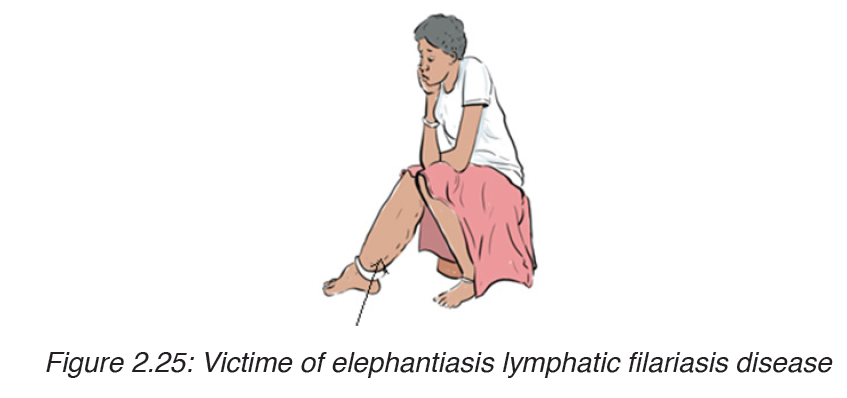
Elephantiasis, also known as Lymphatic filariasis, is a human disease
caused by parasitic worms known as filarial worms.Most cases of the disease
have no symptoms. Some people, however, develop a syndrome called
elephantiasis, which is marked by severe swelling in the arms, legs,breasts
or genitals. The skin may become thicker as well, and the condition may
become painful.
The worms are spread by the bites of infected mosquitoes. Three types of
worms are known to cause the disease: Wuchereria bancrofti,Brugia malayi
and Bruggia timori with Wuchereria bancrofti being the most common.
These worms damage the lymphatic system. The disease is diagnosed by
microscopic examination of blood collected during the night. The blood is
typically examined as a smear after being stained with Giesma stain.

4. Ankilostomiasis
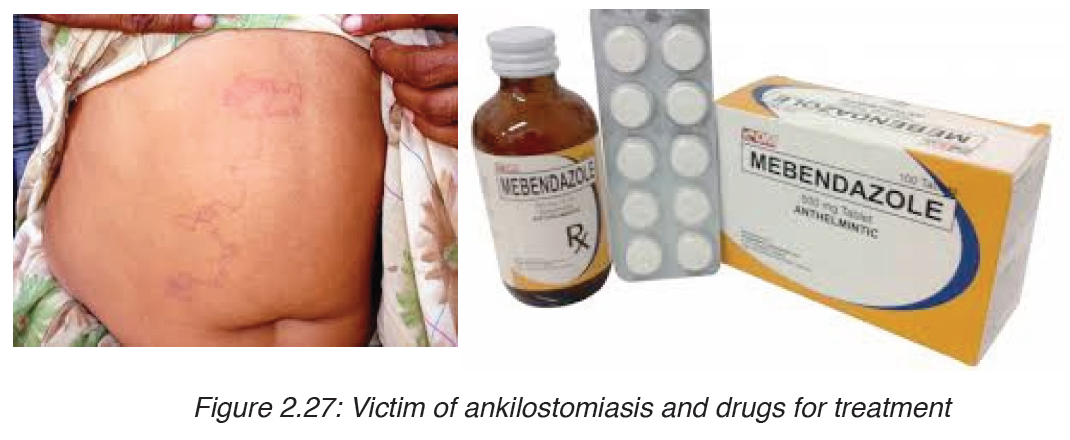
Ankilostomiasis is ahookworm disease caused by infection with Ancylostoma
hookworms. Ankilostomiasis is caused when hookworms, present in large
numbers, produce an iron deficiency anemia by sucking blood from the
host’s intestinal walls.
Signs and symptoms
Depending on the organism, the signs and symptoms vary.Ancylostoma
duodenale and Necator americanus can enter the blood stream while
Ancylostoma braziliensis cannot.
Transmission
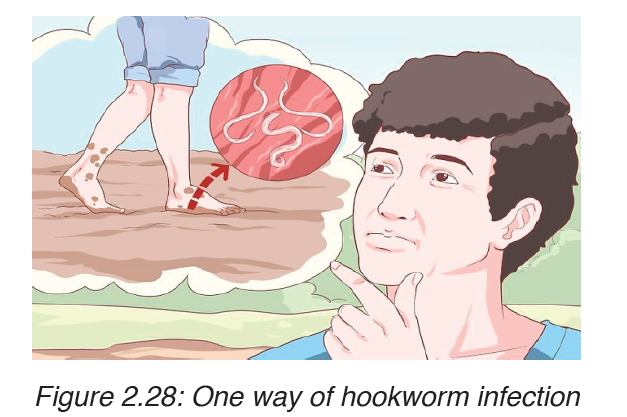
The infection is usually contracted by people walking barefoot over
contaminated soil. In penetrating the skin, the larvae may cause an allergic
reaction. It is due to the itchy patch at the site of entry that the early infection
gets its nickname “ground itch”. Once larvae have broken through the skin,
they enter the bloodstream and are carried to the lungs (however, unlike
ascaris, hookworms do not usually cause pneumonia). The larvae migrate
from the lungs up the windpipe to be swallowed and carried back down to the
intestine. If humans come into contact with larvae of the dog hookworm or
the cat hookworm, or of certain other hookworms that do not infect humans,
the larvae may penetrate the skin. Sometimes, the larvae are unable to
complete their migratory cycle in humans. Instead, the larvae migrate just
below the skin producing snake-like markings.
Prevention
– Control of this parasite should be directed against reducing the level of
environmental contamination.
– Treatment of heavily infected individuals is one way to reduce the
source of contamination.
– improve access to sanitation e.g. toilets
– Wearing shoes when you walk outdoors, especially in areas that might
have feces in the soil
– Drinking safe water
– Properly cleaning and cooking food
– Practicing proper handwashing
Treatment
The drug of choice for the treatment of hookworm disease ismebendazole
which is effective against both species, and in addition, will remove the
intestinal worm Ascaris also, if present. The drug is very efficient, requiring
only a single dose and is inexpensive.
An infection of N. americanus parasites can be treated by using
benzimidazoles, albendazole, and mebendazole.
Application activity 2.1
1. List the ways in which cholera is transmitted from person to person.
2. Explain why there is such a high risk of cholera following natural
disasters such as earthquakes, hurricanes, typhoons and floods.
3. Explain why there is a high death rate from TB in countries with a
high proportion of the population who are HIV-positive.
4. TB is an opportunistic infection. Why?
5. Describe how malaria is transmitted.
6. Describe the biological factors that make malaria a difficult disease
to control.
7. Describe the precautions that people can take to avoid catching
malaria.
8. Which of the following diseases is transmitted by an insect vector?
a) Cholera
b) HIV/AIDS
c) Malaria
d) TB
9. Tuberculosis is a serious infectious disease.
a) Name the causative agent of tuberculosis.
b) Explain how tuberculosis is transmitted.
c) State the regions of the world with the highest number of cases of
tuberculosis.
d) Suggest reasons for the high number of tuberculosis in some parts
of the world.
10. The table shows the number of cases of cholera and deaths from
the disease for the five countries with the greatest outbreaks as
reported to the WHO in 2010.
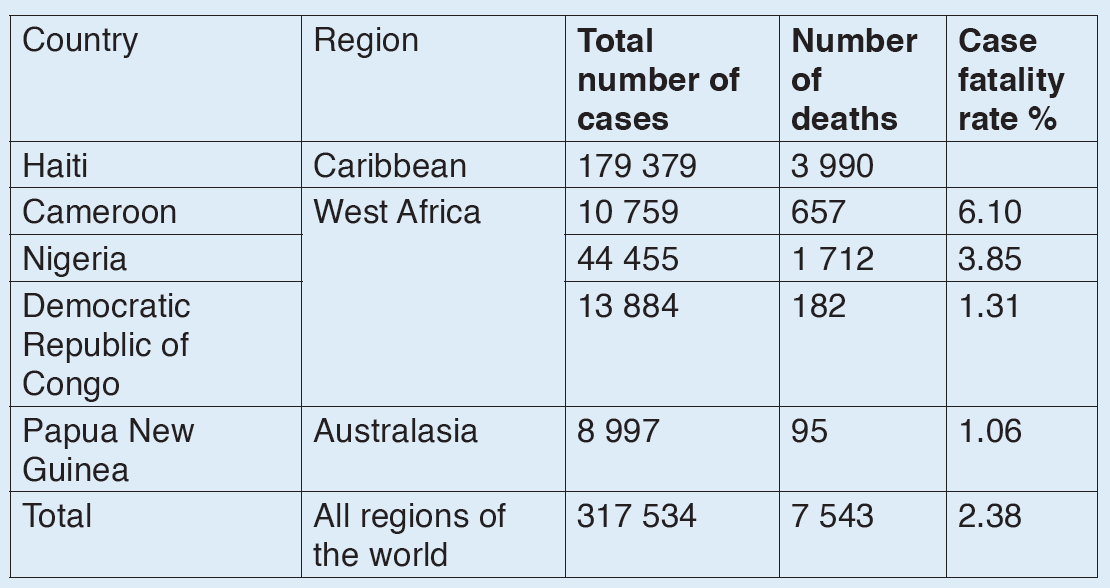
a) Describe how cholera is transmitted.
b) With reference to the table:
i. Calculate the case fatality rate for Haiti in 2010.
ii. Suggest why the case of fatality rate varies between countries.
iii. Explain why it is important that the WHO collects data on
outbreaks of cholera.
c) Explain why there no epidemics of cholera in highly economically
developed countries such as Australia, Malaysia and USA.
2.2. Hygiene practices
Activity 2.2
Discuss the possible hygiene practices you always have every
morning at your school.
It is important to understand family health issues, because poor personal
and environmental hygiene may cause hygiene related diseases. It
is therefore important to acquire knowledge and skills on personal and
environmental hygiene in order to avoid such diseases.
2.2.1. Personal hygiene
Personal hygiene and sanitation is very important because:
– It insures proper growth and development of children.
– It helps to prevent diseases especially hygiene related diseases.
– It prevents bad smell it helps to keep the environment clean, tidy and
beautiful.
– It makes the environment appealing and attractive.
The personal hygiene may be maintained through the hygiene practices
below:
– Washing the body regularly with clean water and soap.
– Wearing clean clothes.
– Living in clean environment with adequate fresh air.
– Eating adequate balanced diet. Young children should be fed between
5 to 6 times per day. Their diet should be rich in proteins.
– Having regular exercises.
To insure personal hygiene, the important aspects below are considered:
Care of body
To prevent skin diseases and bad smell one needs:
– Washing the body regularly with clean water and soap.
– Avoid sharing clothes, socks and towels.
– Wearing clean under wears.
– Stay in clean environment.
– Wear clean clothes.
Care of the feet
– Washing the feet regularly with water and soap.
– Keeping the feet dry to avoid fungi or foot rot and bad smell.
– Wearing clean socks.
– Avoid sharing socks.
– Keep nails short and clean.
– Airing your feet daily.
– Apply some oil like Vaseline to keep the feet smooth.
Care of hands
– Wash hands regularly with clean water and soap.
– Keep nails short and clean.
– Wash hand before touching and preparing the food
– Wash hand before eating.
– Wash hand after visiting the toilet.
– Apply some oil like Vaseline to keep the hands smooth.
Care of hair
– Wash your head regularly with clean water and soap.
– Keep your hair well combed.
– Oil your hair to prevent dandruff.
Care of teeth
– Brush your teeth daily with a tooth brush, clean water and tooth paste.
– Avoid eating too much sweet, biscuits and sugary foods, as they can
cause tooth decay and dental cavities.
– Eating foods that help build strong teeth like milk, eggs, vegetables,
fruits and fish.
– To visit dentist regularly for checkups.
– To avoid putting sharp dirty objects in the mouth.
– Pregnant mothers should feed on dies rich in Calcium which is used to
make teeth.
Care for eyes, ears and nose
These sensory organs are very important. We must care for them well. Injury
may result in permanent disability such as: blindness, deafness and lack
ability to detect smells.
Care of the eyes
– Wash eyes with clean water.
– Protect your eyes from foreign objects and dusts.
– Protect your eyes from too much or too low light. You always read
under adequate light.
Care for ears
– Wash ears with clean water and soap.
– Never insert hard objects in the ear, this may damage your ear and
cause deafness.
– Avoid very loud noise.
– Clean ears with cotton around a matchstick or use ear buds and use it
gently.
Care for the nose
– Never insert hard objects in the nose.
– Keep the nose clean by blowing it regularly.
– Avoid being hit in the nose.
2.2.2. Environmental hygiene
Our surrounding environment including water, air and soil should be protected
and kept clean. There should be different hygiene practices to prevent soil
pollution, water pollution and air pollution.
Application activity 2.2
1) What are possible hygiene activities are required to care for;
a) Eyes
b) Nose
c) Feet
2) Explain the general human body hygiene practices.
2.3 Human immune system: immunity, structure and role of
antibodies, immunization and vaccine
Activity 2.3
The human body is always exposed to environment full of pathogens and
it remains healthy. How is this possible?
IMMUNITY is a process by which the body of a living organism defends itself
against pathogens. The immune system is a protective system that is made
of a series of defenses that fight against diseases by: recognizing, attacking,
destroying and remembering each type of pathogen that enters the body. It
does this by producing specialized cells which inactivate pathogens.
Defense mechanisms against infections
The immune system includes two general categories of defense mechanisms
against infections: nonspecific defense and specific defense.
2.3.1 Nonspecific defenses
They include physical barriers (skin) and chemical barriers (mucus, tears and
sweat) which prevent foreign pathogens from entering the body. Nonspecific
defenses occur into two lines of defense:
a) First line of defense: its function is to keep pathogen out of the body. This
role is carried out by: the skin, sweat, tears and mucus. The most important
nonspecific defense is the skin. The skin epidermis consists of layers of dead
cells called keratinocytes (which have been keratinized: their cytoplasm is
replaced by a protein called keratin). The keratinized layers of dead cells
act as an effective barrier to pathogens and cannot normally be penetrated
by bacteria or viruses.
Likewise, the mucous that line the digestive,respiratory, nose and genitals
block the entry of harmful microbes. Beyond theirrole as a physical barrier,
the skin and mucous membranes counter pathogens with chemicaldefenses.
For example, secretions from sebaceous and sweat glands give the skin an
acidic PH ranging from3 to 5, which kills bacteria. Many secretions of the
body including: tears, mucus and saliva contain lysozyme, ananti-microbial
enzyme that breaks the walls of bacteria. Also, stomach acid and digestive
enzymes destroy many pathogens which are swallowed with the food.
b) The second line of defense: Microbes which have managed to penetrate
the first line of defense face the second line of defense which depends mainly
on phagocytosis,inflammatory response and on certain antimicrobial
proteins.
i. Phagocytosis:
When pathogens are detected in the body, the immune system produces
millions of white blood cells which fight the infection. Many of this white
blood cells are phagocytes, which engulf and destroy bacteria.
The word Phagocyte comes from Greek where: phag means: to eat and
kutos means cell. Thus phagocytes are cells that engulf and destroy
pathogens. There are two types of phagocytes:
• Neutrophils are the common phagocytes produced in bone marrow
and carried in blood to be released in tissue fluid. They will be released
in large number as a result of infection.
The phagocytic cells called neutrophils constitute about 60 % to 70%
of all white blood cells (leucocytes). The neutrophils enter the infected
tissue, engulfing and destroying microbes there.
• Macrophages are large cells manufactured in bone morrow and travel
in blood as monocytes. They tend to be settle in lymph nodes, liver
and in spleen.
How phagocytes work: when pathogens enter the body, phagocytes move
towards them, they engulf and destroy them. Once the phagocyte is bound
to the pathogen, it will envelop it by folding its membrane inwards. The
pathogen is trapped inside the vacuole called phagosome. Lysosomes
fuse with the phagosome and release enzymes called lysins into it. These
enzymes digest pathogens and the end products are harmless nutrients that
can be absorbed into the cytoplasm.

ii. Inflammatory response
One result of phagocytosis is inflammation or inflammatory response
that is characterized by: redness, hotness, swollen and painful at the site
of local infection. An inflammatory response is a nonspecific defense
reaction to tissue damage caused by injury or infection.
The tissues injured by bacteria or physical damage (like a cut) release
chemicals such as histamine and prostaglandins. These chemicals work
as signals which induce an increased heart rate and increased blood
capillary permeability (so that white blood cells get to the site of infection
faster).
Infected cells also release chemicals which attract phagocytes. When
phagocytes and macrophages arrive at the site of injury, they engulf and
destroy pathogens and the tissues heal.
The inflamed tissues contains many bacteria and phagocytes, many of which
die and form the pus. The increased body temperature slows or stops the
growth of pathogens. The fever and increased number of leucocytes are two
indications that the body is working hard at fighting infections
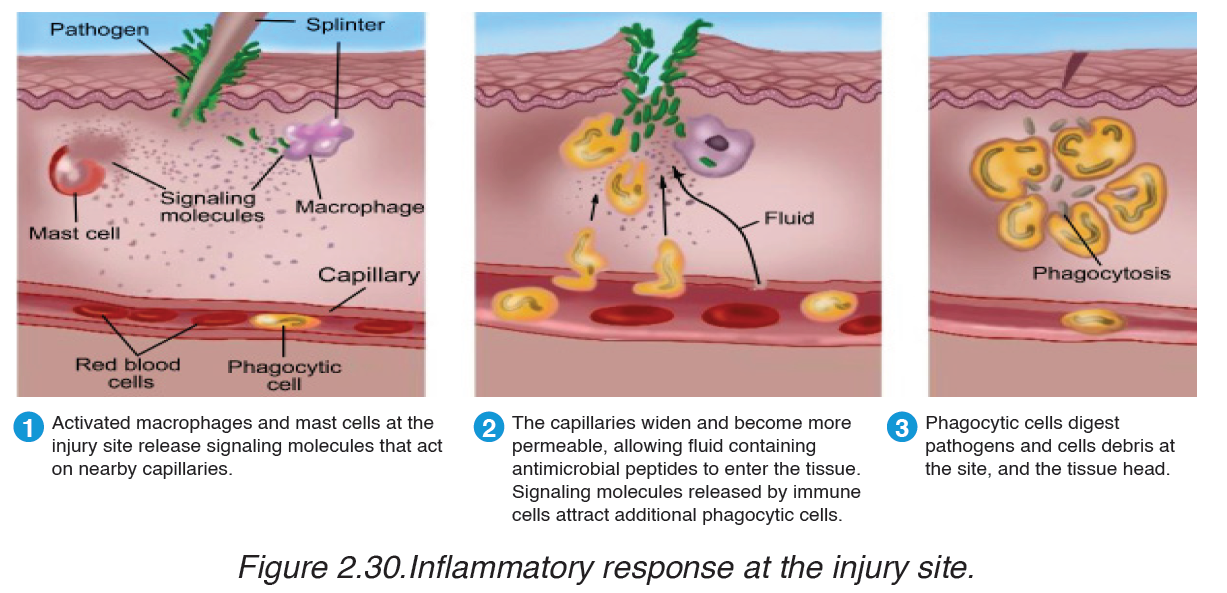
iii. Anti-microbial proteins
Two groups of proteins: interferons and the complement system provide
short-term, nonspecific defense to viral and bacterial infections. Interferons
are proteins secreted by virus-infected cells which inhibit the synthesis of
viral proteins in affected cells and help to block viral replication. They
diffuse to neighboring cells and stimulate them to produce antiviral proteins,
which prevent viruses from multiplying within them.
Interferons also activate natural killer cells and macrophages, which
destroy infected host cells before they release more viruses. Interferons can also promote destruction of cancer cells. The complement system consists of about 30 proteins in blood plasma that function together to fight
infections. These proteins circulate in an inactive state and are activated by substances on the surface of many microbes. Activation results in a cascade of biochemical reactions leading to lysis (bursting) of invading cells. The complement system also functions in inflammation.
2.3.2 Specific defense/immunity: third line of defense
If pathogens are able to get past the body’s non-specific defenses, the immune system reacts with a series of specific defenses that attack the particular disease-causing agent. These defenses are called immune response. A substance that triggers (causes) this response is known as an antigen. Viruses, bacteria and other pathogens may serve as antigens.
The cells of the immune system that recognize specific antigens are two types of lymphocytes:
a) B lymphocytes (B cells): which originate in the bone marrow and migrate to the lymph nodes where they proliferate into plasma cells which produce antibodies.
B cells provide immunity against antigens and pathogens in the body fluid.
B lymphocytes give rise to the humoral immunity or antibody-mediated immunity.
b) T lymphocytes (T cells): originate in bone marrow and migrate into the
thymus. They don’t produce antibodies, but they themselves provide
defense against antigens and pathogens inside living cells. T lymphocytes
give rise to the cell-mediated immunity.
Humoral immunity
When pathogens invade the body, their antigens are recognized by few B
cells of the body. These B cells grow and divide rapidly, producing large
number of plasma cells and memory cells. Plasma cells produce and
release antibodies. Antibodies are proteins that recognize and bind to
antigens. They are carried in the bloodstream to attack the pathogen at the
site of infection. As antibodies overcome pathogens, the plasma cells die out
and stop producing antibodies.
Once the body has been exposed to a pathogen, millions of memory B cells
remain capable of producing antibodies specific to that pathogen. These
memory B cells, greatly reduce the chance that the disease could develop a
second time. If the same antigen enters the body a second time, a second
response occurs. The memory B cells divide rapidly, forming new plasma
cells. Plasma cells produce the specific antibodies to destroy the pathogen
as faster as possible.

An antibody is shaped like the letter Y, and has two identical antigenbinding
sites. The shape of the binding site allows the antibody to recognize
a specific antigen with a complementary shape. The different shapes give
antibodies the ability to recognize a large variety of antigens. A healthy adult
cane produce about 100 million different types of antibodies.
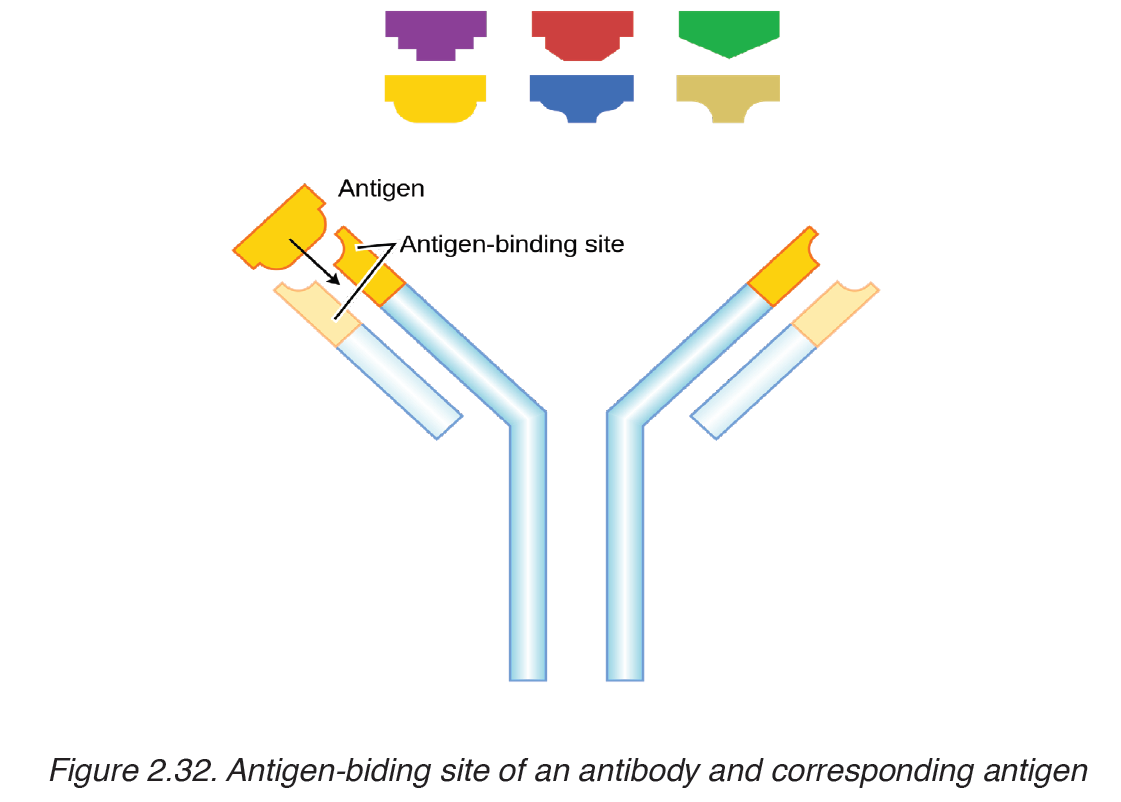
Cell-mediated immunity
It is the body’s primary defense against its own cells when they have become
cancerous or infected by viruses. The cell-mediated immunity is also
important in fighting infection caused by fungi and protists. When viruses
and other pathogens get inside living cells, antibodies alone cannot destroy
them. During cell-mediated immunity, T cells divided and differentiated into:
killer T cells (cytotoxic T cells), helper T cells, suppressor T cells and
memory T cells.
Killer T cells track down and destroy bacteria, fungi, protozoa and foreign
tissues containing antigens. Helper T cells produce memory T cells. The
memory T cells, like memory B cells, will cause a secondary response, if
the same antigen enters the body again. As pathogens are brought under
control, suppressor T cells release substances that shut down the killer T
cells.
Types of immunity
Immunity can be active or passive. In active immunity, the body makes its
own antibodies after exposure to an antigen, whereas in passive immunity,
the body acquires antibodies produced by other person or other animals.
Either active immunity or passive immunity can be naturally or artificially.
Thus, there are four types of immunity:
a) Natural active immunity
In natural active immunity, the body makes its own antibodies, in response
to an antigen.
b) Artificial active immunity
In artificial active immunity, the body makes its own antibodies, as a result
of vaccination against diseases. Vaccination (immunization) is the
production of immunity as a result of injection of weakened pathogens
which cannot cause diseases to the body, but which can induce production
of specific antibodies to those pathogens.
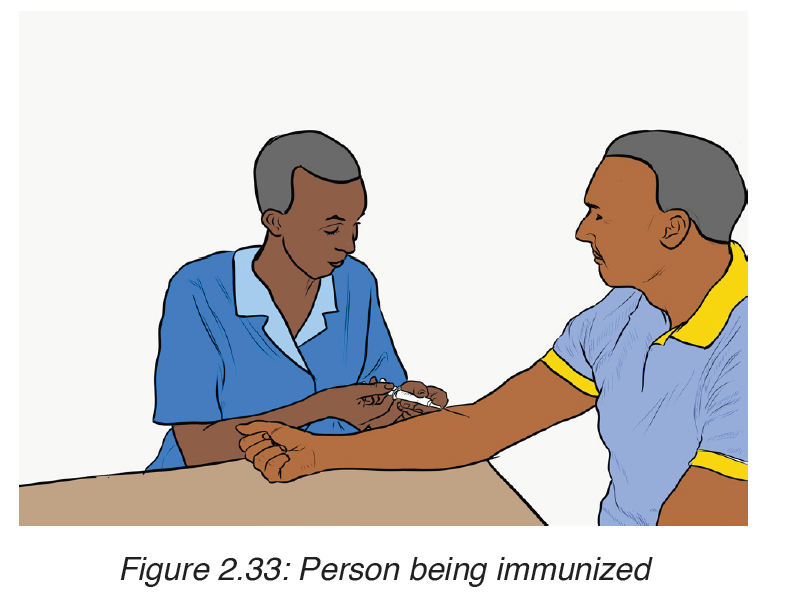
c) Natural passive immunity
Natural passive immunity is a temporary immunity resulting from acquiring
antibodies produced by another individual. The only natural passive immunity
is when a foetus acquires antibodies from the mother, either through the
placenta before birth, or through the breast feeding after birth. This immunity
protects the child against most infectious diseases for the first few months of
its life, or longer, if the infant is breast-fed.
d) Artificial passive immunity
It is a temporary immunity that results from the injection of the serum
containing antibodies from another organism. In this passive form of
immunity, a recipient is not induced to produce his or her own antibodies,
but is supplied with them, from an outside source. For example: the horse
serum well prepared, can then be used to protect humans against diseases.
The trouble with the protection induced by this immunity is that it is shortlived.
Nowadays, the passive immunity is normally used only in emergencies,
when is too rate for active immunization to work quickly enough.
Application activity 2.3
I. Multiple Choice Questions
1. Humoral immunity is carried out by the
a) B lymphocytes
b) T lymphocytes
c) Phagocytes
d) T lymphocytes, phagocytes and NK cells
2. Plasma cells represent
a) B lymphocytes which are actively secreting antibodies.
b) T lymphocytes which are actively secreting cytokines
c) Monocytes which have entered tissues
d) CTL which are secreting perforins.
3. Live attenuated vaccine types have the disadvantage over the inactivated
vaccine types as
a) They require booster shots
b) They do not confer life-long immunity
c) They may mutate to virulent form
d) They do not stimulate the immune system strongly.
4. Immune response is
a) The defense mechanism of our body.
b) Reaction of the cells and fluids of the body.
c) A substance that destroys or inhibits the growth of other
microorganisms
d) None of the above
II. Long Answer Type Questions
1. With an illustrative diagram, state the origin and describe the mode of
action of phagocytes.
2.4. Common addictive substances and their effects
Application activity 2.4

Carefully, Analyze the substances 1-7 in figure above and answer to the
following questions
1. Among those substances which one you use in daily life?
2. Which do you think are dangerous to life?
3. Suggest one effect of each of the dangerous substances
Tobacco, Alcohol and drugs addiction is the physical and psychological
need to continue using these substance, despite its harmful or dangerous
effects.The signs and symptoms of drug addiction drug vary according to the
individual and the substances he or she uses.
2.4.1. Tobacco smoking and its effects
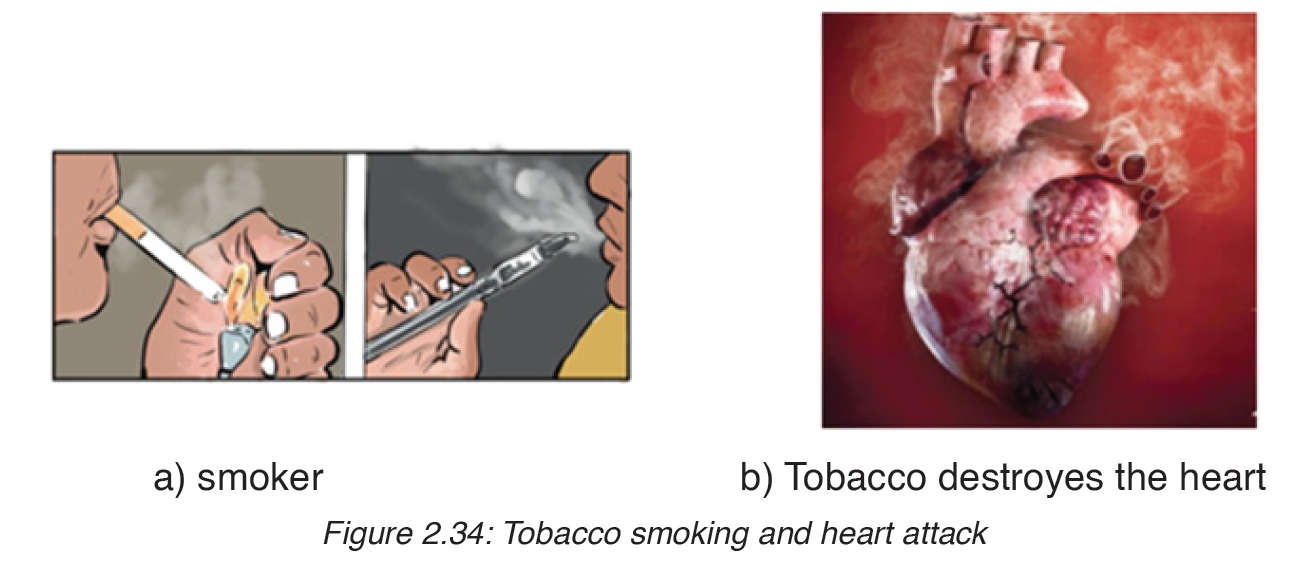
Smoking harms nearly every organ in your body. Among heavy smokers,
two in three will die from a disease caused by smoking. Tobacco smoke
is made up of thousands of chemicals and many of them are very harmful.
Around 70 of them cause cancer. Cigarette smoke contains over 4000
different chemicals. Many of them are harmful. The most harmful substances
in cigarette smoke include: nicotine, carbon monoxide and tar.
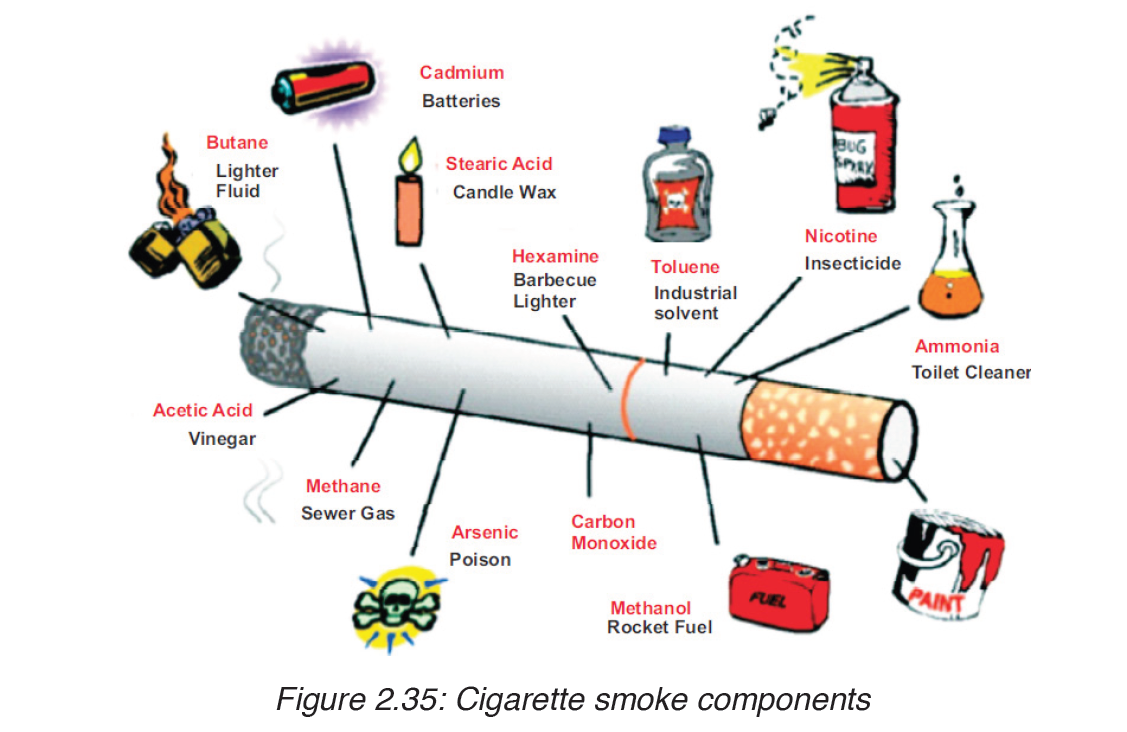
Cigarette smoke contains over 4,000 chemicals, including 43 known
cancer-causing (carcinogenic) compounds and 400 other toxins. These
cigarette ingredients include nicotine, tar, and carbon monoxide, as well as
formaldehyde, ammonia, hydrogen cyanide, arsenic, and DDT. Nicotine is
highly addictive.
a) Effects of Tar and carcinogens in tobacco smoke on the gas
exchange system
Tar is a combination of severe chemicals lying on the lining of the airways
and alveoli. This increases the diffusion distance for Oxygen entering the
blood and CO2 leaving the blood. The lumen of airways gets smaller and this
restricts the flow of air to the alveoli. The tar paralyses or destroys the cilia
on the surface the airways, so they are unable to move the mucus away.
Bacteria and viruses trapped in mucus are not removed. They can multiply
in the mucus and may block the bronchioles and affect breathing process. A
combination of bacteria, viruses and mucus in airways and alveoli causes
the lungs to be more susceptible to infections. Smokers are more likely to be
attacked by influenza and pneumonia.
Tar contains also the carcinogen compounds which cause cancer. When
the tar lies on the surfaces of airways, carcinogens enter the cells of lung
tissues. They enter the nucleus of these cells and have a direct effects on
their genetic material. Any change on genetic material is called mutation,
if mutations affect the genes that control cell division, then uncontrolled cell
division take place. This is cancer. Lung cancer often takes 20-30 years to
develop, and a cancer may grow for many years before it is discovered.
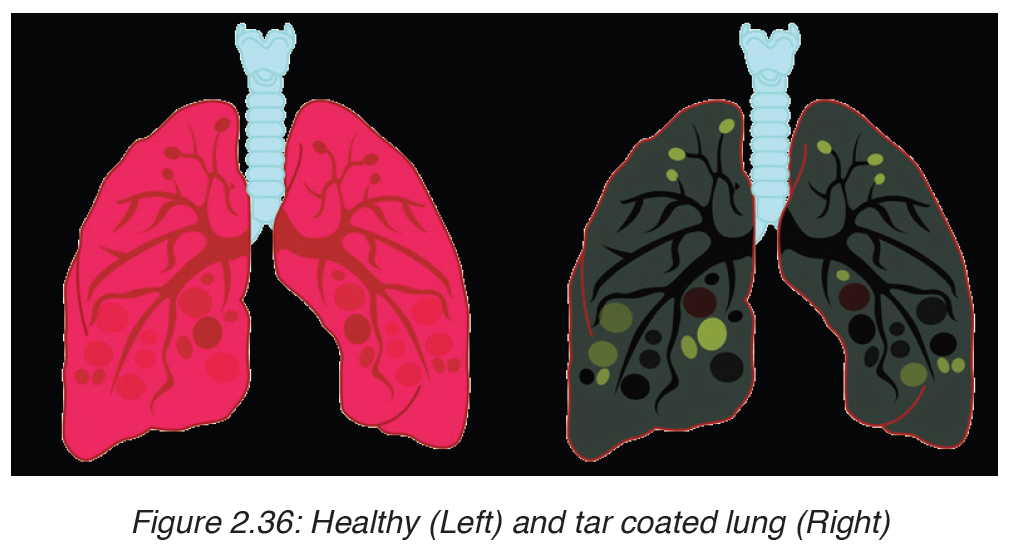
b) Effects of Nicotine and carbon monoxide on the cardiovascular
system
i. Carbon monoxide (CO): is fatal in large amount. This poisonous
gas is also found in car exhaust fumes. CO enters the red blood cells
and combines with haemoglobin more rapidly than Oxygen, and form
the carboxyhaemoglobin. This reduces the oxygen-carrying capacity
of blood, preventing your lungs, heart, and other organs from getting
oxygen they need to function properly. CO can also damage the lining
of arteries, and may rise the heart beat rate.
ii. Nicotine: is a poisonous alkaloid drug that is additive. 60 mg of
nicotine placed on the tongue would kill an individual within minutes.
It is absorbed by the body very rapidly, reaching the brain in less than
30 seconds.
It is a highly toxic chemical and its manufacture, use and sale is
controlled under the State Poisons Acts, except where it occurs in
tobacco.This exception of tobacco is for political reasons, not because
nicotine is deemed ‘safe’ in cigarettes. Nicotine, once inhaled, affects
the body very quickly. It causes changes to the structure and the
working of the brain, which lead to nicotine addiction. Nicotine also
raises heart rate, blood pressure, releases hormones (adrenaline)
affecting the central nervous system, and constricts small blood
vessels (arterioles) under the skin. In the long term, nicotine may be a factor in causing coronary disease. It is believed to be involved
in the development of gastrointestinal disorders and problems during
pregnancy, and is linked with the development of cancers.
c) Contribution of tobacco smoking to atherosclerosis and
coronary heart disease
i. Atherosclerosis is the deposition of fatty substances in the walls of
the arteries. The CO in the cigarette smoke can damage the inner
lining of arteries. This encourages the deposit of fatty substances like
cholesterol on the walls of arteries. This reduces the lumen of arteries,
which reduces blood flow, and causes high blood pressure.

ii. Coronary heart disease (CHD) is a disease of the heart caused by
malfunction of the coronary artery. Coronary arteries are the arteries
which carry blood to the heart.
The nicotine and carbon monoxide found in cigarette enter the lungs
and diffuse into blood in blood capillaries, that conducting them into
coronary arteries. This causes the atherosclerosis in coronary arteries,
which reduces the blood flow in the heart muscles which receive less
oxygen for respiration. This can lead to coronary heart diseases, which
take three forms: In circulatory system, they cause changes which lead
to cardiovascular diseases like:
iii. Angina: a severe pain in the chest, which may extend down the left
arm or up into the neck.
iv. Heart attack or myocardial infections: caused by a clot in the
coronary arteries, blocking the flow of blood to the heart muscles.
v. Heart failure: when the heart cannot sustain its pumping action. This
can be caused by the blockage of the major coronary arteries.
d) Symptoms of lung cancer and chronic obstructive pulmonary
diseases (COPD)
– Chronic obstructive pulmonary disease: is a combination of
diseases that include chronic bronchitis, emphysema and asthma.
The symptoms of COPD are a combination of symptoms of chronic
bronchitis, and of emphysema.
– Chronic bronchitis: is the inflammation of the airways. This is
accompanied by damage to the cilia and the over production of mucus.
The symptoms are: irritation in lungs, continual coughing, and coughing
up mucus that is often filled with bacteria and white blood cells.
– Emphysema: is the loss of elasticity in alveoli, which causes the alveoli
to bust. The symptoms are: short breath, hard exhalation, the blood is
less well oxygenated and fatigue occurs.
– Lung cancer: the symptoms of lung cancer can be recognized by:
continual coughing, shortness of breath, pain in the chest and the blood
coughed up in the sputum is often the first sign of the lung cancer.
e) Evidences linking cigarette smoking to diseases and early
death.
i. Links of cigarette smoking to early death
– Regular smokers are three times more likely to die prematurely than a
non-smoker.
– 50% of regular smokers are likely to die of a smoking-related disease
– The more cigarettes a person smokes per day, the more he is likely to
die prematurely.
ii. Links of cigarette smoking to lung cancer
– A smoker is 18 times more likely than a non-smoker to develop lung
cancer.
– 25% of smokers die of lung cancer.
– A heavy smoker (more than 25 cigarettes a day) is 25 times more likely
than a non-smoker to die of lung cancer
– The chances of developing lung cancer reduce as soon as a person
stops smoking.
iii. Links to other lung diseases
– COPD is rare in non-smokers
– 98% of people with emphysema are smokers.
– 20% of smokers have emphysema
2.4.2. Alcohol
Alcohol is any organic compound in which the hydroxyl functional group (–
OH) is bound to a carbon. The term alcohol originally referred to the primary
alcohol ethanol (ethyl alcohol) which is used as a drug and is the mainalcohol
present in alcoholic beverages.
Alcohol is produced by adding yeast on a liquid that contains sugar in absence
of oxygen. This yeast ferment sugar to produce energy, alcohol and alcohol.
Most popular alcohol containing drinks include fermented drinks such as
beer and wine, other drinks such as vodka, whiskey, scotch, and gin are
made by distillation
Effects of alcohol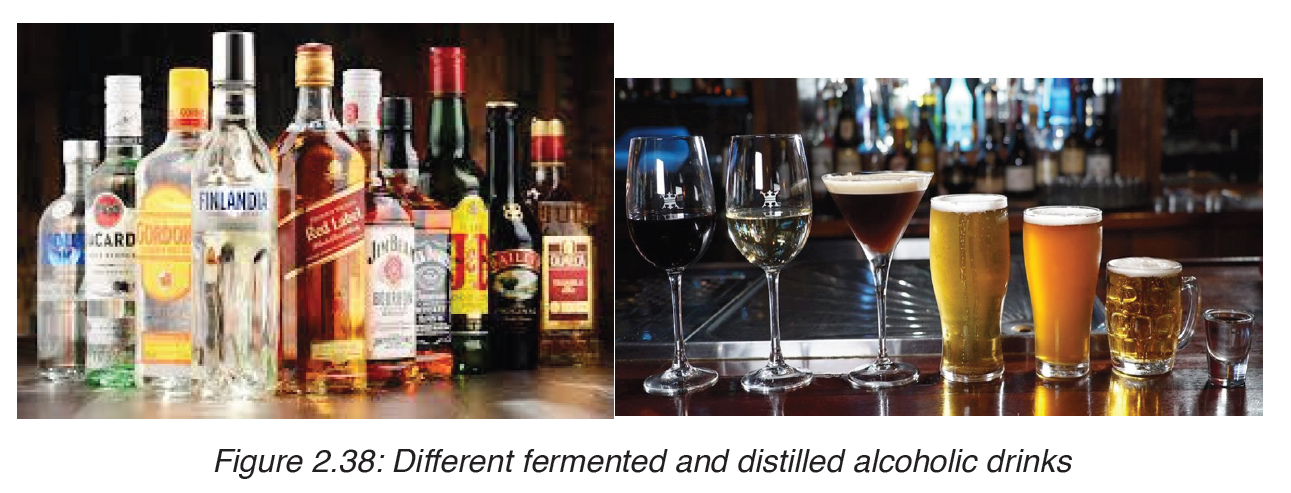
The effects of alcohol vary from person to person. While some people may
be able to limit their drinking, others have a difficult time controlling their
alcohol consumption.
Effects of alcohol include: Slurred speech, vision impairment, lack of
coordination, extreme shifts in mood, memory lapses and slowed breathing.
The most immediate alcohol effects are on the nervous system. The small
dose of alcohol slows down the rate of nervous system functions. So, alcohol
is a depressant.
The pregnant women who drink regularly, run the risk of” fetal alcohol
syndrome”or damage to the developing babies due to the effect of alcohol.
People who have become addicted to alcohol suffer from a disease called
alcoholism. If someone cannot work effectively without alcohol, that
indicates an alcohol abuse problem.
Taking alcohol in excess leads to damage of neurons in the brain, cells in the
liver. The damage of liver cells causes the live to become less able to deal with high amount of alcohol, then the formation of the scar tissue known as
cirrhosis in liver occurs. Finally the drinker may die from the chronic liver
failure.
Basing on the effect of alcohol on nervous system, driving can lead to suddenaccident that may kill people.
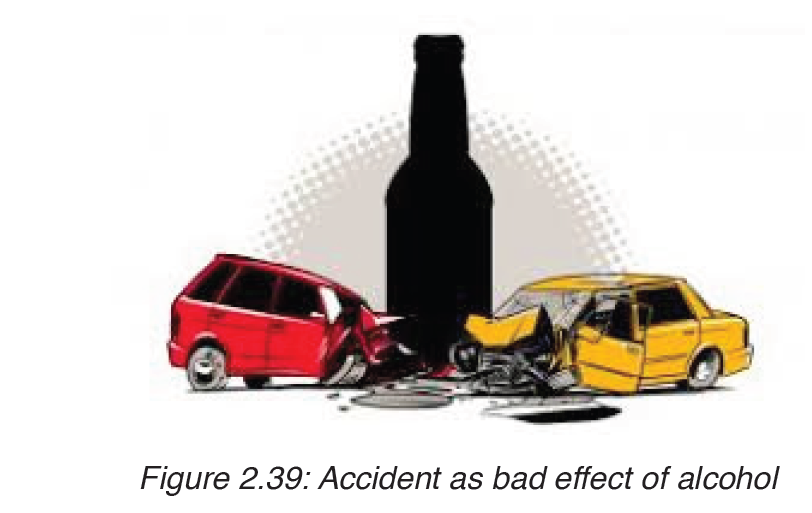
2.5.3. Drugs
Drug is any substance that cause a change in the body. Drugs affect the
body in different ways, because some are very powerful and dangerous and
their possession is not allowed. Other drugs like penicillin and codeine are
drugs that can be used under the supervision of doctor.
All drugs (legal and illegal ones) have the capacity of harming life if they are
abused. In this section, some of the most commonly abused drugs and the
way they affect the body will be considered.
Drugs affect the particular system of the body like digestive and circulatory
systems.
The following are the most powerful drugs that can also affect the nervous
system and their negative side effects.

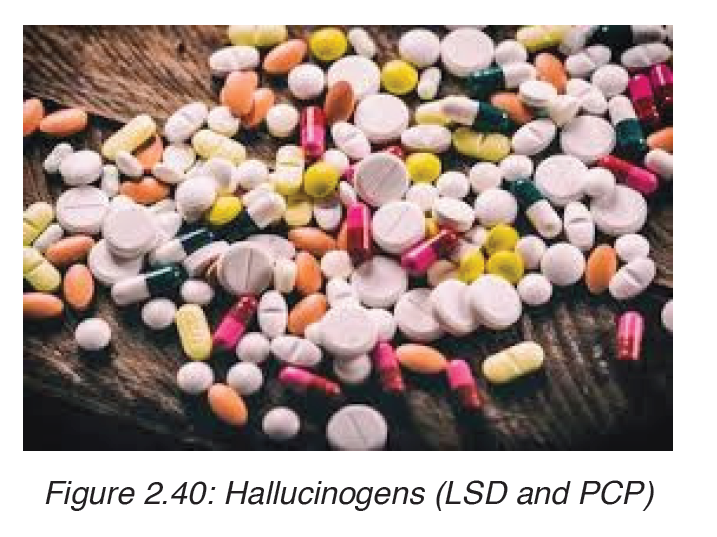
a) MARIJUANA ( Also called Hashish or Hash)
i. Negative effects of using marijuana
– Addiction: Marijuana is physically addictive and psychologically
addictive, especially as it concerns younger.
– Memory Loss: People who always use marijuana developed a poorer
verbal memory in middle age than people who didn’t smoke.
– Social Anxiety Disorders: Regular use of marijuana can lead to mental
health issues such depression, anxiety and even schizophrenia.
– Paranoia: researches indicated that the use of marijuana can lead
users to feel a sense of paranoia as a result of the changes in their
sensory perception
– Heart Damage: Marijuana can also significantly raise a person’s heart
rate for up to three hours. Even, people who use marijuana are more
likely to have a stroke https://www.livescience.com/58210-stroke-heartfailure-
linked-to-marijuana.html at some point in their lives than people
who didn’t use it.
– Other effect are: Lung problems, low testosterone, appetite
irregularities, risk of greater potency, decrease in motor
Responses, poor decisions.
b) HALLUCINOGENS
Hallucinogens are drugs that cause hallucinations. Users see images,
hear sounds and feel sensations that seem very real but do not exist. Some
hallucinogens also produce sudden and unpredictable changes in the
mood of those who use them.
There are many types of hallucinogens but the two common types such
as LSD(Lysergic acid diethylamide ) and PCD(Phencyclidine) are the ones
which are used.
LSD is a powerful hallucinogen that interferes with the normal transmission
of nerve impulses in the brain. Its effects vary from person to person and all
people who use LSD regularly have abad trip. Some of LSD users have lost
touch with reality after only one single dose.
PCP produces fillings of strength and great power. High dose of PCP heart
attacks. The users of PCP often become extremely violent and are danger
to themselves and others.
c) STIMULANTS
These are drugs that speed up the actions of nervous system. The most
powerful stimulants are Amphetamines, these chemically resemble natural
neurotransmitters found in the body ( Compounds that pass nerve impulse
from one neuron to another). Once amphetamine enters the blood stream, it
floods the body and behaves like neurotransmitters. This causes the nervous
system to increase its activity producing a feeling of strength and energy in
the user body. Later the user suffers from fatigue and depression as the
nervous system becomes unable to handle the overstimulation produced by
amphetamines after their dose wears off.
Long-term use of amphetamines causes hallucinations, circulatory problems.
Psychological difficulties.
d) DEPRESSANTS
These are drugs that reduce the rate of nervous system activity. These drugs
are also known as downers. People become dependent on them as long as
they use them. Example of downers is barbiturates. Use of the barbiturates
with alcohol is fatal, because the nervous system becomes so depressed
and breath stops.
The barbiturates abuse is danger because it brings about serious medical
problems that must be immediately treated once the user stops supplying
the drugs to the body.
e) COCAINE
This drug is compound extracted from leaves of coca plant. Users supply it
to the body by smoking it, sniffing it or inject it into the bloodstream.

Cocaine stimulate the release of neurotransmitter called dopamine which is
normally released by the brain if person is satisfied during lunch or dinner.
So, cocaine creates feeling of pleasure and satisfaction
i. Effects of using cocaine

– Heavy use of cocaine leads to lung damage similar to emphysema.
Overdose stops breathing.
– Use of cocaine increases the heart rate and blood pressure leading to
risk of irregular heartbeat or even heart attack.
– Cocaine causes extreme mood changes, irritability. Long-term use can
lead to psychological problems.
– Cocaine causes the users to experience the sensation of bugs crawling
over the skin.
– Cocaine usage reduces a desire for food, leading to body weight loss.
f) OPIATES
This is a group of drugs produced from the opium poppy. The most common
opiates are opium produced directly from the opium poppy. Other examples
of opiates are morphine and heroin which are forms of opium. Apart from
heroin, other opiates can be used under supervision of doctor to reduce
severe pain as they are used as pain killers. If opiates are taken in large
dose, they can result to death.
In addition, opiates such as heroin, are example of drugs that cause a strong
physical dependence. The regular user becomes addicted and the nervous
system becomes also dependent on the supply of drugs. Any attempt of
withdrawal or stopping the use of drug will cause severe pain, nausea, chills and fever.
Application activity 2.4
I. Choose whether the following statements are True (T) or False (F)
1. Smoke from cigarettes can make non-smokers sick.
2. Smoking can affect a person’s ability to smell and taste food.
3. Secondhand smoke kills about 3,000 non-smokers each year from lung disease.
4. It takes about ten seconds for nicotine absorbed into the
bloodstream to reach the brain.
5. Smoking is a difficult habit to quit.
6. Nicotine, the chemical found in cigarettes, is an addictive drug.
7. A smoker is twice as likely to have a heart attack as a non-smoker is.
8. Cigarette brands that are heavily advertised on TV, in magazines,
on billboards, and on T-shirts are the brands more teens buy.
9. One out of every ten smokers will die of a smoking-related sickness.
10. More germs get into your lungs when you smoke.
II. Suggest the components of a tobacco smoke
III. Give the effects of alcohol on human body health
SKILLS LAB 2:
After studying this unit” Common diseases and hygiene”, and after finishing
their studies as well as working as cooperative, Student-teachers will help
society by creating a center for people workshop about nutrition, hygiene
and sanitation, so that different diseases can be eradicated from Rwanda society.
They will be helping people to fight against malnutrition by talking about
deficiency diseases and how they can prevent them. Here every house
should have its own vegetable plantation around kitchen.
Sensitization about general body hygiene, food hygiene, clothes hygiene,
home hygiene, water sanitation will be the first priority. And again, according
to what they have acquired from the school student-teacher will help people
to know all method of cooking like:
a) Boiling: this is a method involving cooking food completely covered
with water and boiling it until fully cooked
b) Steaming: this is cooking food using steam from boiling water.
c) Frying: this method involves cooking food with hot fat or oil.
d) Stewing: this involves cooking food with low quantities of water.
e) Roasting: this involves cooking food with very hot radiant heat
f) Baking: this involves cooking food using a direct heat
g) Grilling: this involves cooking food with direct heat using a grill.
These methods will be very important in preventing from being infected by
disease germs from uncooked food. Again good storage and preservation
are very significant in preventing many infectious diseases.
Conclusion: This unit will lead student-Teachers when they are still at
school or at home to protect their own life, and even the society life.
End unit assessment 2
I. Choose whether the given statements are True (T) or False (F)
1. Innate immunity is present at birth.
2. Breast milk confers protection to newborn by providing IgE type of antibodies.
3. Antibodies can work by promoting phagocytosis of microbial agents.
4. Antibiotics help a patient in mounting an effective immune response.
5. Treating tuberculosis is becoming difficult because Mycobacterium tuberculosis has become resistant to a number of antibiotics.
6. High fever is a generalized allergic reaction caused by release of active mediators from mast cells.
7. Secondary immune response appears much faster because of the presence of memory cells persisting from previous infection.
8. Vaccination against snakebite is an example of passive immunization.
9. Allergies are of two types—innate and adaptive.
10. Beta-lactam antibiotics kill bacteria by blocking synthesis of their cell walls.
II. Long answers type questions
1. Answer the following questions
a) Name the causative agent of tuberculosis.
b) Explain how tuberculosis is transmitted.
c) State the regions of the world with the highest number of cases of tuberculosis.
d) Suggest reasons for the high number of tuberculosis in some parts of the world.
2. State why vaccination programs are able to eradicate smallpox but not measles, TB, malaria or cholera.
3. Compare roles of B cells and T cells in the immune response.
4. Name organism which have the following effects on health
